Lecture V
Dornach, 28th November 1916

Rembrandt Self-portrait 1639 |
Continuing our series of
lantern lectures, we will today pick out a single artist — albeit
one of the very greatest in the artistic evolution of humanity. I refer
to Rembrandt.
In this case the former
kind of introduction, indicating the historic background of the artist's
life and times, would be a little out of place. With an individual artist
such as Rembrandt, it is more important to give ourselves up to the
immediate impression of his works — so far as is possible through
some few reproductions. For only when we bring before our souls in sequence
at least a few of his main works, — only then do we realise how
unique a figure is Rembrandt in the history of mankind. We should, indeed,
be adopting a false method if we tried — as in the case of
Michelangelo, Raphael and others — to reveal the background of his
creations more from the point of view of the history of his times. For
Rembrandt, as a human phenomenon, stands, to a great extent, isolated.
He grows out of the broad foundations of the race. In his case it is far
more important to see how he himself stands in the stream of evolution
— to see what radiates from him into the stream of evolution —
than to attempt to describe him as a product of it.
This is the essential point
— to recognise the immense originality which is peculiar to
Rembrandt. As an isolated phenomenon of history, he grows out of the broad
mass of the European people, once more bearing witness to the truth that
when we contemplate the creative work of human individualities, we cannot
simply construct a succession of historic causes and effects. Sooner
or later we must realise the fact that just as one plant in the garden,
standing beside another in a row, has not its cause in the neighbouring
plant, so the successive phenomena of history have not always their
causes in the preceding ones.
As the plants grow forth
from the common soil under the influence of the common sunlight, so
do the phenomena of history grow from cut a common soil, conjured forth
by the activity of the Spiritual that ensouls humanity.
In Rembrandt we must look
for something elemental and original. Many people in Mid-Europe began
to feel this very strongly about the end of the eighties and the beginnings
of the nineties of last century. It was curious to see what a far-reaching
influence a certain book had which was published about that time. The
book was not exactly about Rembrandt, but took its start from
Rembrandt.
When I left Vienna at the
end of the 1880s, I went out of an atmosphere in which everyone was
reading and discussing this book Rembrandt as an Educator, by a
German. Such was its title. I found the same atmosphere when I
came to Weimar, and it went on for two or three years longer. Everyone
was reading Rembrandt as an Educator. I myself — if I may
interpolate this remark — found the book to some extent antipathetic.
To me it was as though the author — undoubtedly a man of keen
perceptions — had written down on scraps of paper in the course
of time, all manner of ideas that had occurred to him. He might then
have thrown them all together into a little box, shaken them up, and
taken them out at random and so compiled his book. So confused were
all the thoughts — so little logical sequence — so little
system was there in the book.
However unpleasing from
this point of view, the book nonetheless expressed something of great
significance, especially so for the close of the 19th century. People
investigated in all directions to discover who the unknown author might
be. He had at any rate succeeded in writing out of the hearts of very
many people. He felt that the spiritual and intellectual life of men
had lost connection, as it were, with the mother-soil of spiritual life.
Human souls no longer had the force to penetrate to the heart and center
of the Cosmic Order, to draw from thence something which could give
them inner fullness and satisfaction. The anonymous writer was everywhere
referred to as der Rembrandt Deutsche, — the Rembrandt —
German. His desire was to bring the life of the human soul back again to
an elemental and original feeling of what pulsates as the underlying
heart of things — even in the phenomena of the great world. He
wanted to bring them thoughts of an awakening — calling out aloud
to mankind: “Remember once more what lives in the elemental depths
of the soul! You have lost touch; you are trifling everywhere on the
surface of things — in science and scholarship, and even in your
cultivation of artistic taste. You have lost the Mother-Earth of spiritual
life. Remember it once more!”
To this end he would take
his start from the phenomenon of Rembrandt and he therefore called his
book Rembrandt as an Educator. He found the conceptions and
ideas of men floating about on the surface; but in Rembrandt he saw
an individuality who had drawn from the very depths of elemental human
forces.
If you look back on our
lectures here at Dornach during the last few weeks, you will realise
— what we cannot but realise — that the inner intensity of
spiritual life had declined considerably in Europe in the last decades of
the 19th century. In all directions it had become essentially a culture on
the surface. Even the great figures of the immediate past were appreciated
only in a superficial way. What, after all, did the late 19th century
(I refer to wider circles, a few individuals always excepted) understand
of such writers as Goethe or Lessing? They understood practically nothing
of their greatest works.
The
“Rembrandt-Deutsche”
felt, as I have said, that the soul's power of perception must be brought
to feel and realise once more all that is elemental, all that is truly
great in human evolution. True, if we feel, perhaps, in a still deeper
way than he, what was and still is needful for our age, we cannot go
all the way with him. Indeed, his limitations — bowed themselves
in the subsequent course of his life. There was a deep sincerity of
feeling in the “Rembrandt-Deutsche;” yet, after all, he
was too much a child of his age to realise that a renewal of all spiritual
life was necessary by a discovery of those fundamental sources which
we, in our movement of Spiritual Science, are trying now to bring before
our souls. All people of that time passed by unheeding — passed
by what was “in the air,” if I may use the trivial expression:
the need for a spiritual-scientific movement. Most of them, after all,
continue to do so to this day.
The
“Rembrandt-Deutsche”
made a brave beginning. “Look,” he said, “look what
it means to wrest one's way through to such resources of humanity as
Rembrandt reached!” Yet when all this had been living in his soul,
he probably fell more and more into a kind of despair — despair
of the presence of any such living sources in the evolution of mankind.
Eventually he went over to Catholicism. Thus, after all, he tried to find
in something from the past — in old tradition — a consolation
for the vain quest on which he had so bravely started in his book. His
impulse did not carry him far enough to reach that spiritual life which
is needed to sustain the future. None the less, we cannot but feel with
him what he felt about Rembrandt.
(I may add that the name
of the “Rembrandt-Deutsche” afterwards became known; his
name was Langbehn.)
Rembrandt is not at all
dependent on that artistic movement which I have characterised in recent
lectures as the Southern European stream. He is even less dependent than
Dürer was. Truly, one might say that not in a single fiber of his
soul was he in any way dependent as an artist on the Latin, Southern
element. He stands on his own ground entirely, creating out of the
Mid-European life — out of a source of life which he draws from the
deep well-springs of the people. What was the time when Rembrandt lived
and worked? It was when the Thirty-Years' War was ravaging Mid-Europe.
Rembrandt was born in 1606;
in 1613 the Thirty-Years' War began. Thus we may say that while the
more southern nations of Middle Europe were being massacred in this
War, Rembrandt, in his North-Western corner of the land, was bringing
forth the unique creations of his genius out of the very essence of
Mid-European humanity. He never even saw Italy. He had no relation to
any nature like the Italian. He fertilised his imagination simply and
solely out of the Netherlands nature that surrounded him. He made no
studies as other painters of his country did — studies of Italian
pictures or anything of that kind. Rembrandt stands out as the
arch-representative of those who felt themselves in the 17th century so
completely — albeit unconsciously — as citizens of the new
Fifth post-Atlantean age.
Let us pass in review before
our souls what had happened from a certain moment onward until Rembrandt's
time. Hermann Grimm, who undoubtedly had a feeling for such things,
considered the creations of Art as the purest flowers that mark the
historic evolution of mankind. From the aspect of artistic history,
artistic evolution, he threw many a beautiful and brilliant search-light
on the history of Europe — notably in that time when the Fourth
post-Atlantean age was playing over into the Fifth. We ourselves, in
recent lantern lectures, have brought before our souls the flowering
of artistic life in that age. Hermann Grimm rightly says that to understand
what took its start in that period we must go back to the Carolingian
era. Nothing can teach us to understand so well what was living in the
age of Charlemagne as the Song of Valthari, written by a monk of St.
Gall in the 10th century, and relating how Mid-Europe was overwhelmed
from Italy, telling of all the destinies that overcame Mid- Europe.
(In style and form, however, the Song of Walthari — like many
other works of Art which we have shown — betrays strong Latin,
Roman influences.)
Then we come to the gradual
emerging of a new age. We find, developing in Mid-Europe, the Latin
element in architecture and sculpture. We find the gradual penetration
of the Gothic. We witness the life of this Gothic and Latin Art in the time
of the poets in Wolfram von Eschenbach, and Walther von der Vogelweide.
And we see how the Mid-European freedom of the cities — the culture
of the free cities — comes to expression in the works —
especially in the domain of sculpture — which we showed last time.
At length we come to the Mid-European Reformation, expressing itself in
the great figures of Albrecht Dürer, Holbein and others. Then, as we
indicated when speaking of Michelangelo, there came the
Counter-Reformation, spreading out over all Europe.
Once more, this is visible
in the realm of Art. Hermann Grimm rightly remarks that throughout this
period, when the powers of mighty States were overwhelming Europe, sweeping
away the political individualities, in this period of the great
Principalities, there arose what is made visible in the Art of Rubens,
Van Dyck, Velasquez. With all their greatness, when we call to mind these
names we cannot but find expressed in them something connected with the
Counter-Reformation — with the will to break up the Mid-European
people.
Rembrandt, on the other
hand, is an artist who makes felt — as an artist — something
that contains the highest and strongest assertion of human individuality
and human freedom, and his creations spring from the deep originality
of this same people.
It is wonderful to see
how in Rembrandt has continued what I have already explained in the
case of Dürer — the weaving in the elemental play of light
and darkness. What Goethe afterwards achieved for Science (although
Science to this day does not accept it, not having yet advanced so far
— but it will become so in good time) — the discovery in
light and darkness of an elemental weaving on the waves of which the
true origin of color itself is to be sought — this, I would say,
lights up in the realm of Art for the first time in Dürer and finds
its highest expression in Rembrandt.
The greatness of the Italian
Masters of painting lay in the fact that they raised the individual
appearance to the sublime — to the typical. Rembrandt is the faithful
observer of the immediate reality. But he observes it not in the spirit
of Classical antiquity, for he belongs to the Fifth and not to the Fourth
post-Atlantean age.
How does Rembrandt observe
the reality? He confronts the object as an outsider — really and
truly as an outsider. Fundamentally speaking, even Leonardo, Michelangelo
and Raphael, living as they did in the Fifth post-Atlantean age, could do
no other than confront the object as men stand outside it. But they still
let themselves be fertilised by what came over to them from antiquity.
And thus, if I may say so, it was only half-outwardly that they confronted
the object. Rembrandt confronted it altogether outwardly, and yet in
such a way as to bring it — albeit from without — all his
own full inwardness of soul. But to bring inwardness to the outer object
in this way is not to carry all manner of things into it out of the
egoism of one's human personality. It is, rather, to be able to live
with that which works and weaves in space.
Rembrandt was a man who
wrestled on and on for decades, — we might almost say, from period
to period of five years, and his pictures bear witness to his continual
wrestling and his constant progress. This wrestling essentially consists
in the ever more perfect working out of light and darkness. Color to
him is only that which is born, as it were, out of the light and the
darkness.
What I said of Dürer
— that he looked not for the color which wells forth from within
the object, but for that color which is cast on it from outside —
applies in a still higher degree to Rembrandt. Rembrandt lives in the
surging and weaving of the light and dark. Hence he delights to observe
how the play of light and dark brings forth its remarkable plastic painting
effects in a crowd of figures. The Southern painters took their start
from composition. Rembrandt does not do this, though in the course of
his life, because of the elemental forces working in him so strongly,
he rises to the possibility of a certain composition. Rembrandt simply
sets down his figures; he lets them stand there and then he lives and
weaves in the element of light and shadow, tracing it with inner joy
as it pours itself out over the figures. And as he does so, in the very
life and movement of the light and darkness, a Cosmic, universal principle
of composition comes into his pictures.
So we see Rembrandt (if
I may so describe it) painting plastically but painting with light and
darkness. And by this means, although he only directs his gaze to the
outer reality — not to be the sublimer truth like the South-European
painters, but to the actual reality — he still lifts his characters
to a spiritual height. For that which floods through the realms of space as
light and weaves in them is the element we must always seek in Rembrandt;
by virtue of it he is the great and original spirit that he is.
You will recognise this
if you let pass before your mind's eye the whole succession of these
pictures. Rembrandt is first of all an observer, trying faithfully to
reproduce what Nature puts before him.
Then he gets nearer and
nearer to the secret of creating out of the light and the darkness,
until at length his figures only provide him with the occasion, as it
were, to reveal the working of the pure distribution of light and darkness
in the realm of space. Then he is able to reveal the mysterious fashioning
of sublimer forms out of the light and darkness. The plastic forms of
outer reality only provide him with the opportunity. We see emerging more
and more in Rembrandt's work as time goes on, the boldest imaginable
distributions of light and dark. When we stand face to face with his
creations we have the feeling: all these are no mere figures that stood
before him in space, as models or the like. The essential thing is
altogether different; it is something that hovers over the figures. The
figures only provide the occasion for what Rembrandt was essentially
creating. He created his great works by using his figures, as it were, to
catch the light. The figures give him the opportunity to seize the light.
The essential is the play of light and darkness which the figures enable
him to grasp. The figures merely stand there as a background; the real
work of Art springs from this intangible element which he attains by
means of the figures.
To look in Rembrandt's
works for the particular subjects which the pictures represent, is to
look past the essential work of Art. It is only when we contemplate
what is poured out over the figures that we see what is essential in
Rembrandt. The figures are no more than the medium for what is poured
out over them.
Of such a nature is the
delicate, intimate quality of the creations especially of his middle
period. Unfortunately we cannot show this, because the reproductions
are in black and white; but it is most interesting to see in the middle
period of his work how really the colors in his pictures are created
out of light and shade. The colors are everywhere born out of the light
and the darkness. This artistic conception becomes so strong in Rembrandt
that towards the end of his life's work, color recedes, as it were,
into the background, and all painting becomes for him a problem of light
and darkness.
It is deeply touching from
a human point of view, to witness what wrestles its way through to outward
existence from decade to decade in Rembrandt's work. For it is undeniable
— great as was his talent, his artistic genius from the very first
— he was not yet profound; he could not yet reach into the depths
of things. What he created to begin with is great in its way, yet it
somehow is lacking in depth.
Then about 1642, he suffered
a grievous loss — a loss for his whole life. He lost the wife
whom he loved so tenderly, and with whom he was so united that she was
really like a second life to him. But this loss became for Rembrandt
the source of a great, an infinite deepening of soul. Thus we see how
his creations gain in depth from this time onward — grow infinitely
richer in soul-content than before. Henceforth it is no longer merely
Rembrandt, the man of genius — henceforth it is no longer merely
Rembrandt, the man of genius — henceforth it is Rembrandt deepened
in his own inner life and being.
Considering Rembrandt
comprehensively, we must say that here at last we have the painter of the
beginning of the Fifth post-Atlantean epoch in the fullest sense of the
word. For as you know, we describe the basic character of this epoch when
we say that the Spiritual Soul, above all, is now wrestling its way into
existence. What does this signify for Art? It signifies that the artist
must stand over against his object from without. He lets the world work
upon him objectively, yet in such a way that there is still a universal
spirit in his contemplation, for otherwise he would be creating merely out
of human egoism. The very fact that he confronts the world, and even
man himself, as an outer object, gives him the possibility of seeing
infinitely much that could not be seen in former ages.
What, after all, would
be the meaning of Art if it were only to produce the reality as human
beings see it in ordinary life? It is the very purpose of Art to reproduce
what is not seen in the everyday life.
Now it is natural in the
epoch of development of the conscious Spiritual Soul that man should turn
his attention, above all, to man himself and to all that is expressible
through man. The artist of the Fourth post-Atlantean age, as I have
so often told you, created more out of an inner feeling of himself —
out of an inward experience of his own being. The artist of the Fifth
post-Atlantean age — and this is true in the highest degree of
Rembrandt — creates from outward, contemplative vision. But this
signifies for man an artistic process of self-knowledge. And I think
we are pointing to no matter of chance when we recall the fact that
Rembrandt painted so many portraits of himself. I think there is a deep
and significant meaning in the fact that he had to seek again and again
for self-knowledge as an artist. His own form was not merely the most
convenient model at his disposal — certainly it was not the most
beautiful, for Rembrandt was not a handsome man. No, for him the important
thing was to become progressively aware of the harmony between what
lives within and what can be observed from without — to become
aware of this harmony at that very place where it can best be studied
— in the self-portrait.
Undoubtedly there is a
deeper meaning in the fact that the first great painter of the Fifth
post-Atlantean age painted so many portraits of himself.
We might continue for a
long time, my dear friends, making one observation or another about
Rembrandt. The result would only be to make us realise more and more
how he stands out as an isolated phenomenon through his age, though
in this isolation he creates out of the very fountain-head, out of the
well-spring of Mid-European spiritual life. For Rembrandt creates out
of the spirit which is characteristic of Mid-Europe. To create, to look
at the outward reality, not merely seeking to observe it realistically,
but with a gaze that fertilizes itself with that by which man's gaze
can, indeed, be fertilized — with the surging, weaving, elemental
world. And for the painter, this signifies the light and dark, surging
upon the waves of color, till the outward reality is merely the occasion
to unfold this living and weaving in the light and dark and in the world
of color.
We will now consider a
few of Rembrandt's characteristic pictures, and see how these things
can be traced in his works:
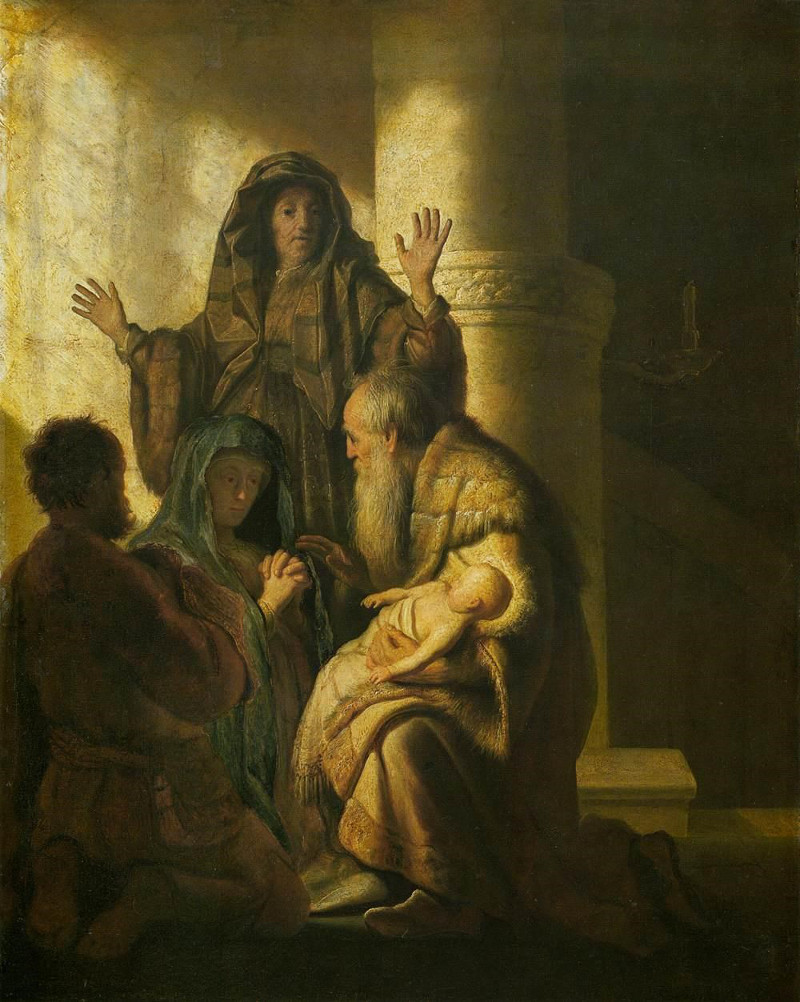
496. Presentation of Jesus in the Temple. (Galerie
Weber. Hamburg.)
Here you see at once how
what I indicated just now shows itself in actuality. In Rembrandt's
work, even when we stand before the colored paintings, we have the feeling
that what lives in color is already there potentially in the light and
shade. This must always be borne in mind.
When we let this or any
other pictures of Biblical history by Rembrandt work upon our souls, we
are struck by a peculiar difference between him and Rubens, for instance,
or the Italian Masters. Their presentations of the Biblical figures
are always somehow connected with the sacred Legends. Rembrandt's are
quite obviously the work of a man who reads the Bible for himself.
We can remember that the
time of his creative work was near the climax of that period when Roman
Catholicism, and, above all, Jesuitism, was waging an inexorable war
on all Bible-reading. Bible-reading was anathema; it was forbidden.
Meanwhile, on this Dutch soil which had just freed itself from Southern
influence and Southern rulership, there arose the strong impulse to
go to the Bible itself. They drew their inner experience from the Bible
itself — not merely from Catholic legend and tradition. Such was
the inspiration of the scenes which Rembrandt treats so wonderfully
with his rays of light and dark.
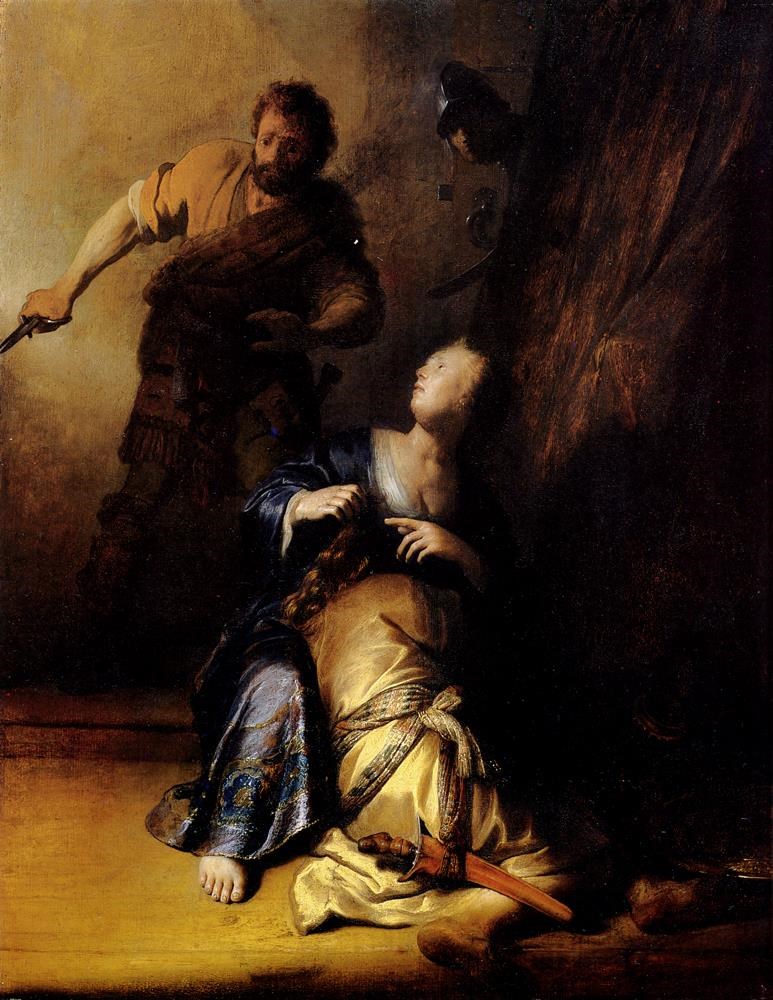
497. Samson and Delilah, 1628.(Kaiser Friedrich Museum.
Berlin.)
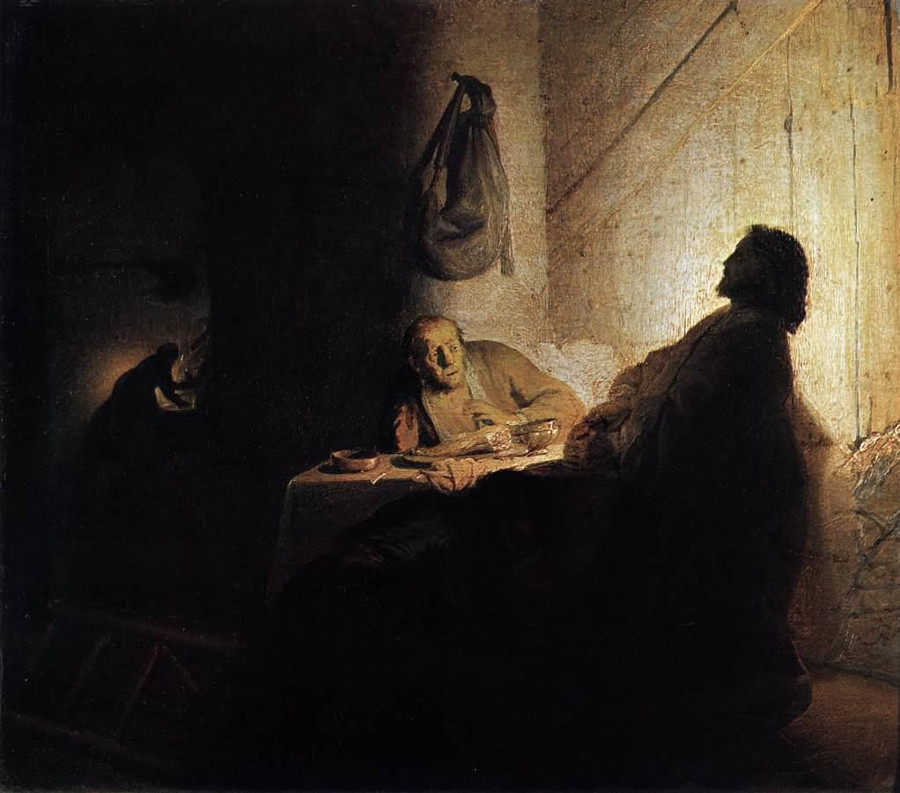
498. Christ and the Disciples at Emmaus, 1629.
(Paris.)
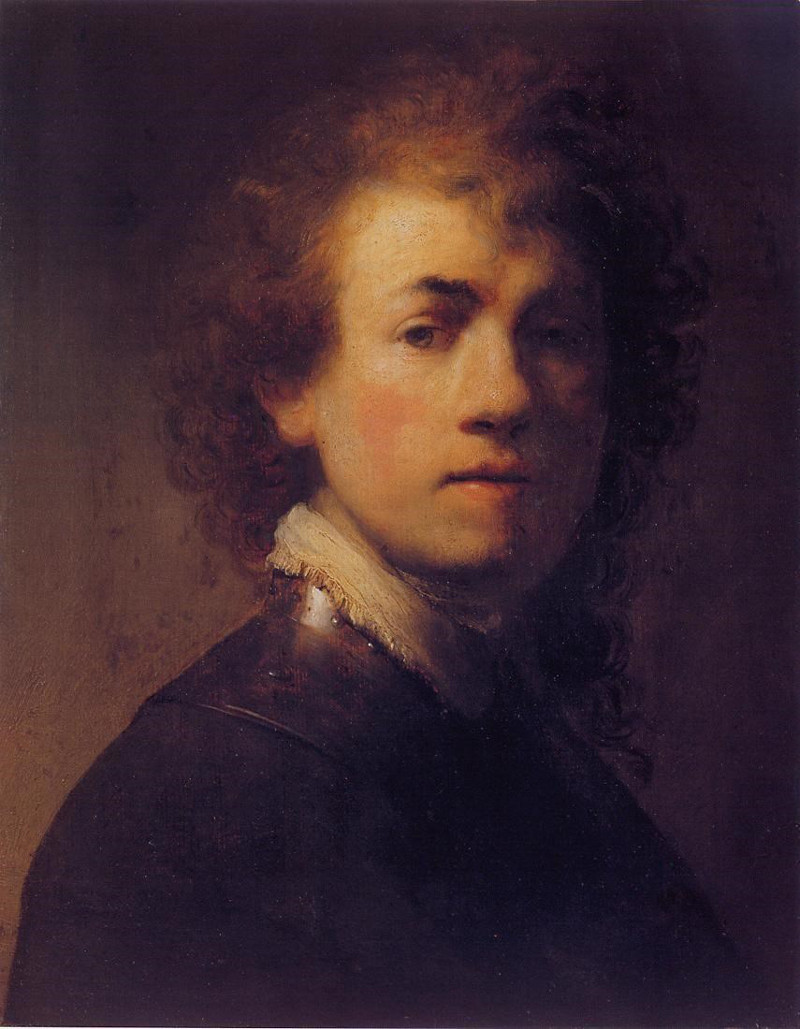
528. Portrait of Himself. (The Hague.)
Even the dress is arranged
in such a way as to express his favorite element of light and shadow.
He even liked to use a metal collar on which the light could glisten.
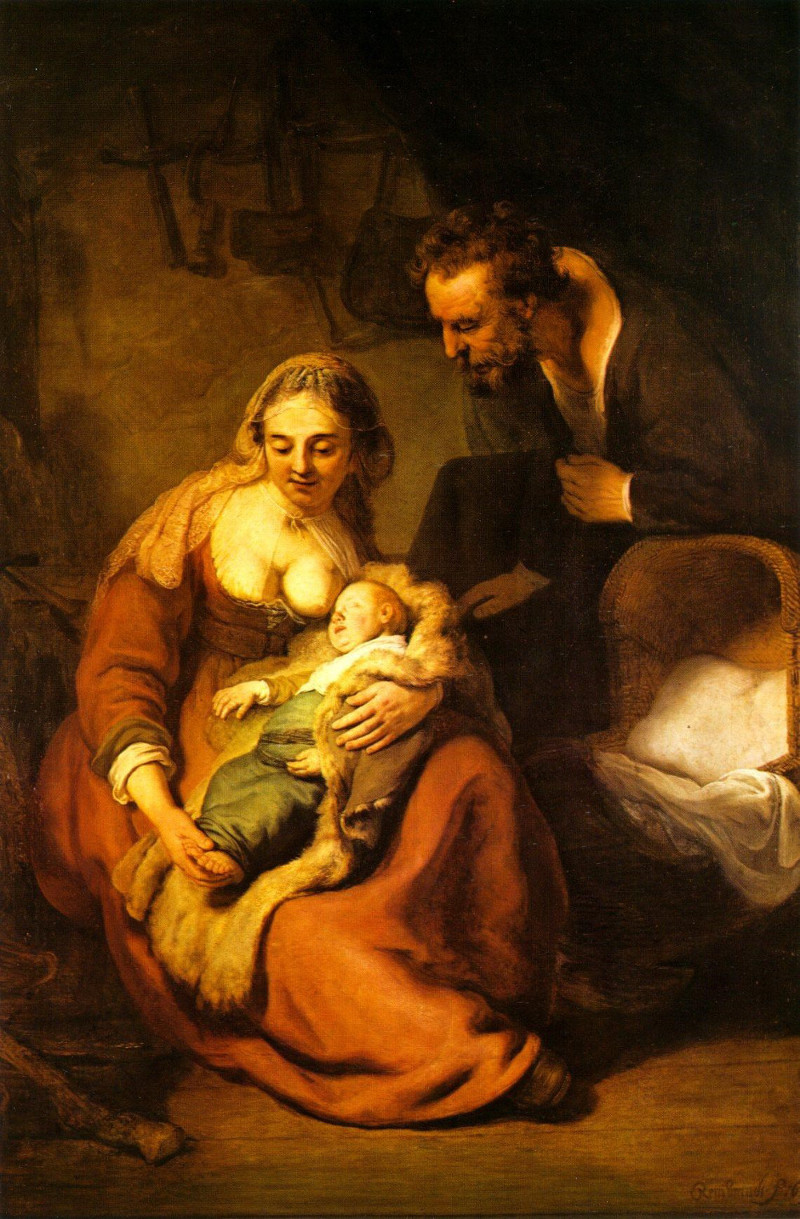
499. Holy Family, 1630 or 1631.(Alto Pinakothek.
Munich.)
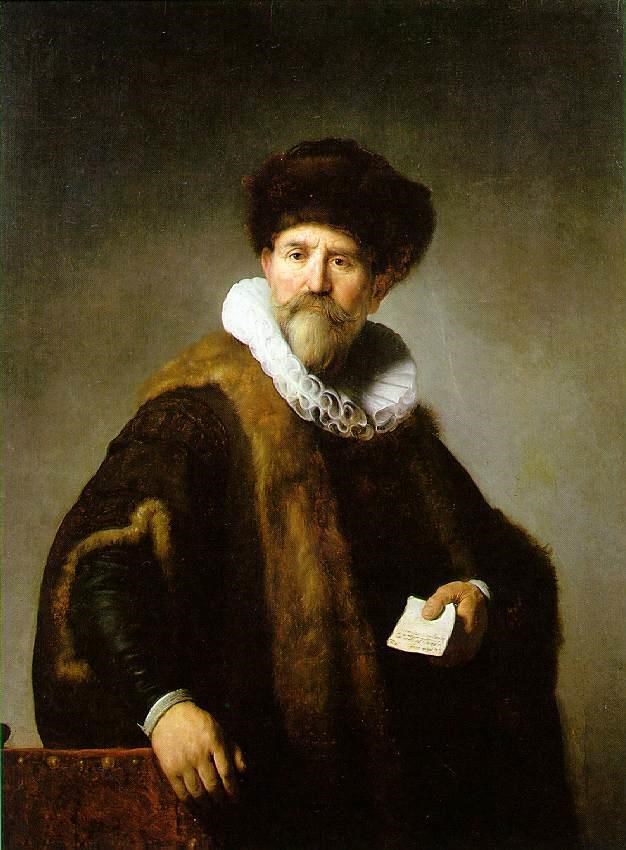
500. Portrait of Nicholas Ruts, 1631.(London.)
This portrait will certainly
confirm what I said just now, and it will show you another thing at
the same time. Under the influence of his artistic way of feeling —
although the reality is by no means lifted into realms of fancy —
the life of the soul comes to expression with great depth.
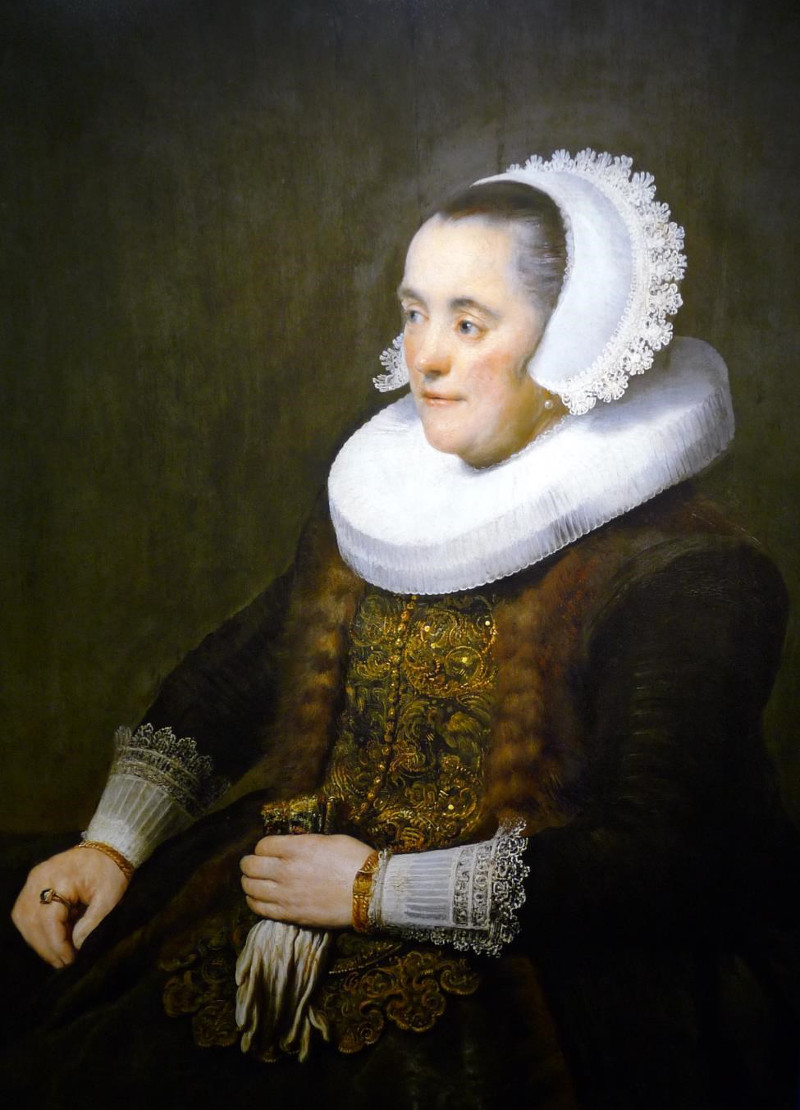
501. Mother of Jacob de Wet. (Vienna.)
The purest study in light
and darkness. Here you will feel what I tried to characterise briefly in
the introduction. All that you see here — the architectural and all
the other features — merely provided the occasion for the real work
of Art, which lies in the distribution of the light itself.
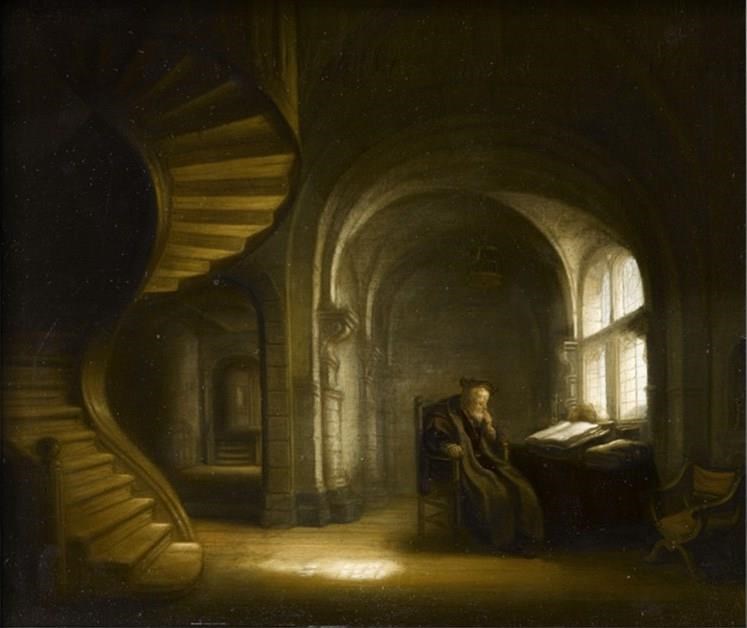
502a. Philosopher in Meditation. (Louvre. Paris.)
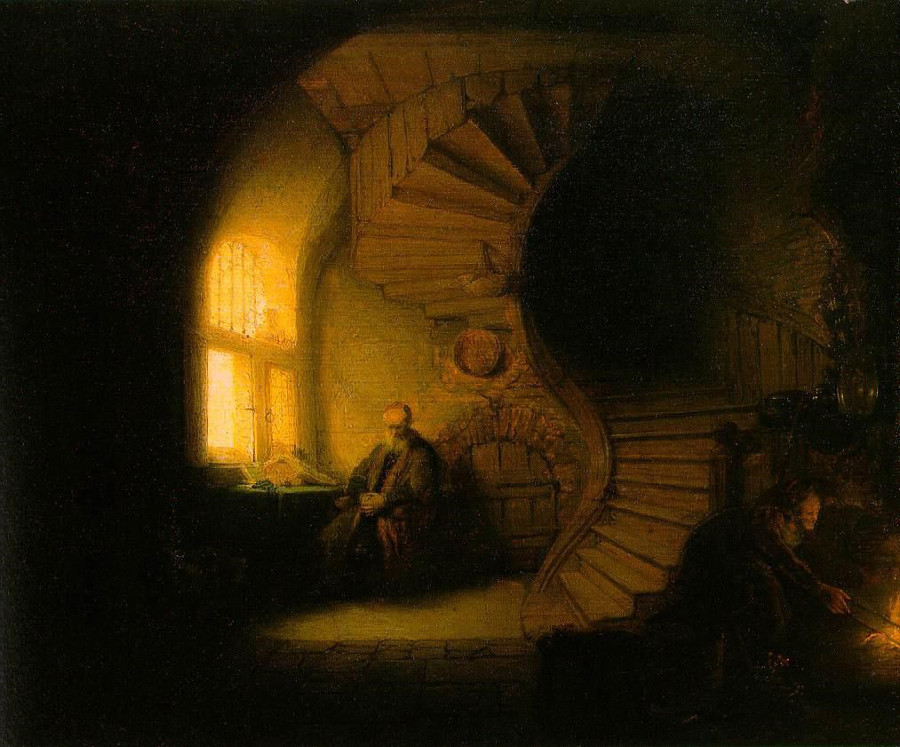
502b. Philosopher in Meditation by Koninck (Rembrandt
School)
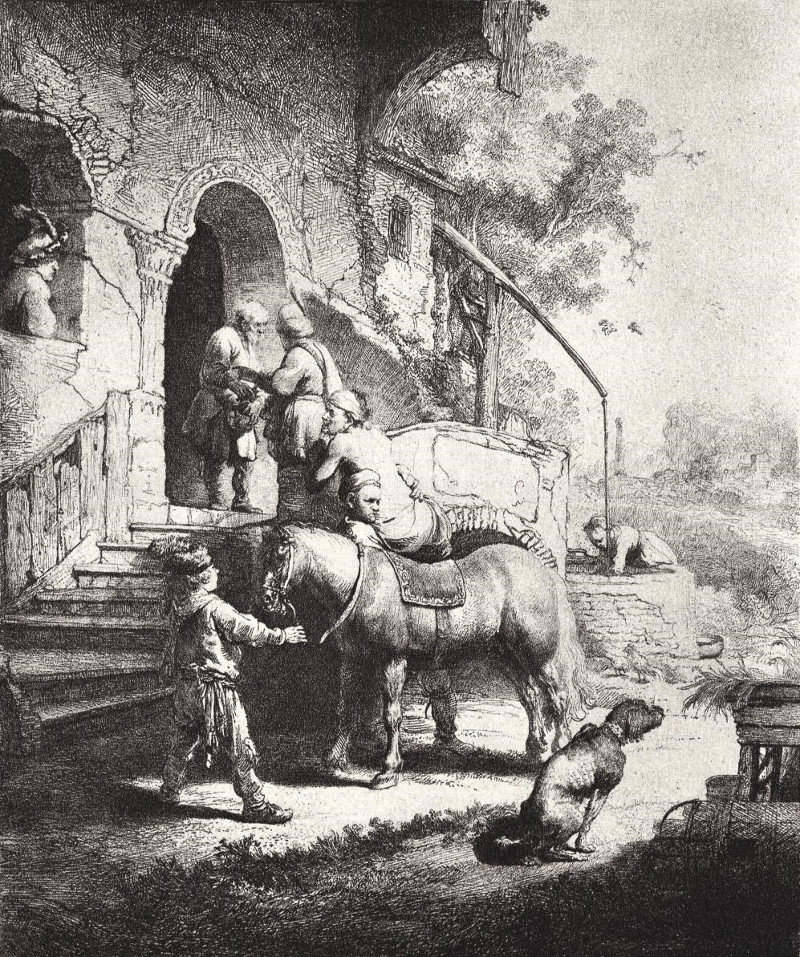
556. The Good Samaritan. (Amsterdam.)
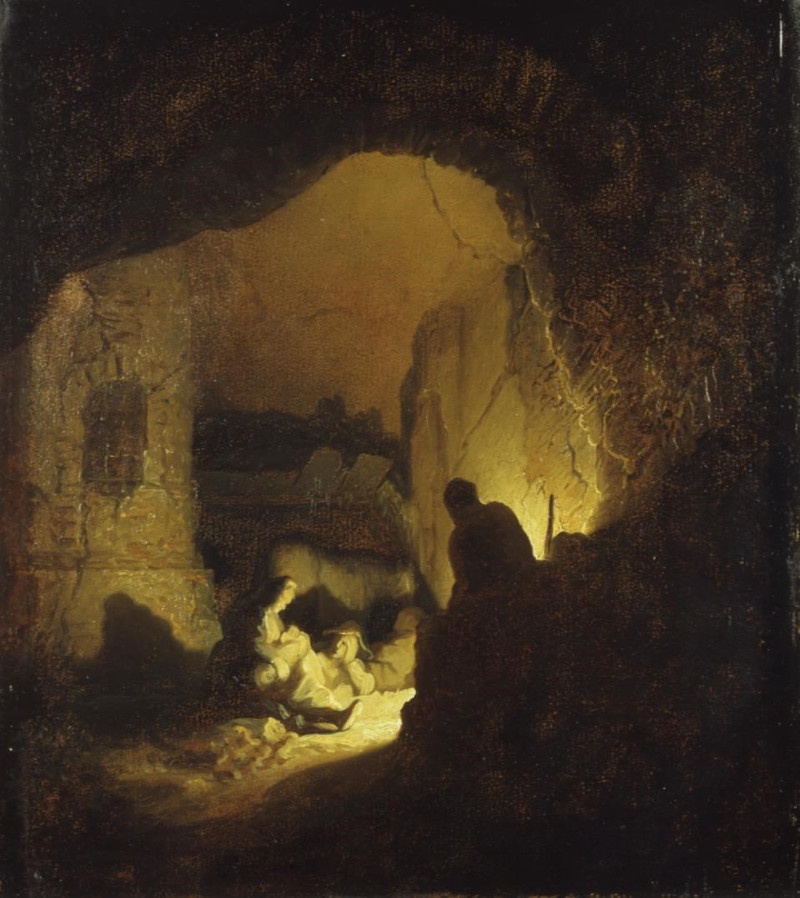
503. Rest on the Flight, 1631. (The Hague.)
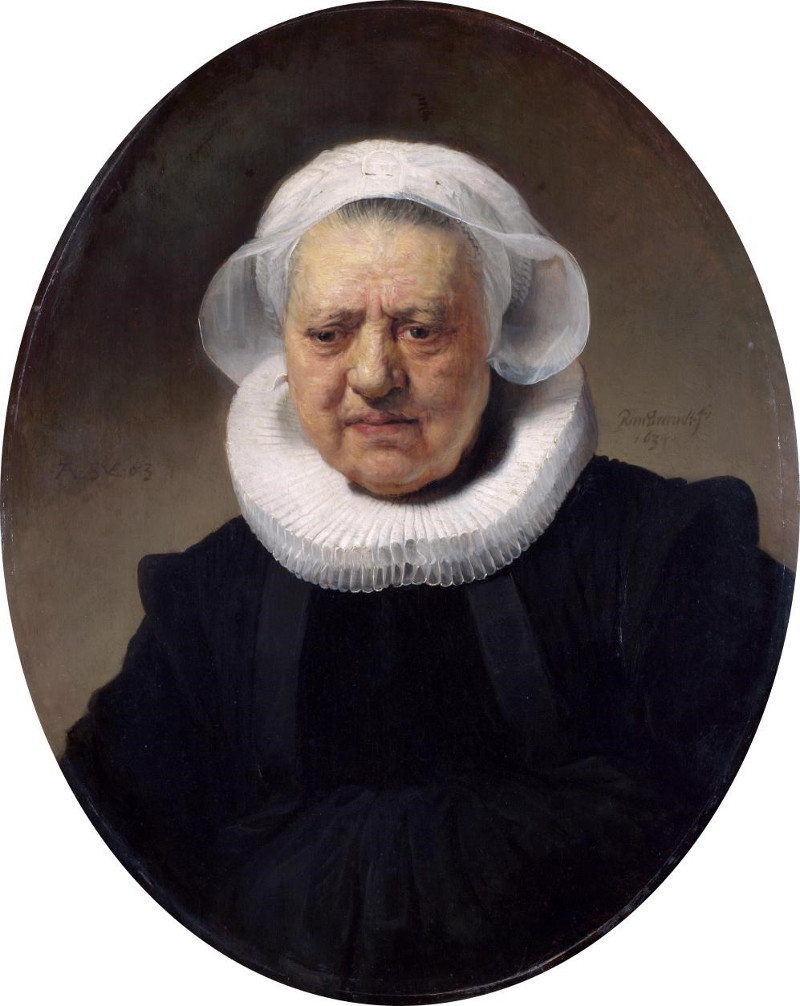
504. Old Woman. (London.)
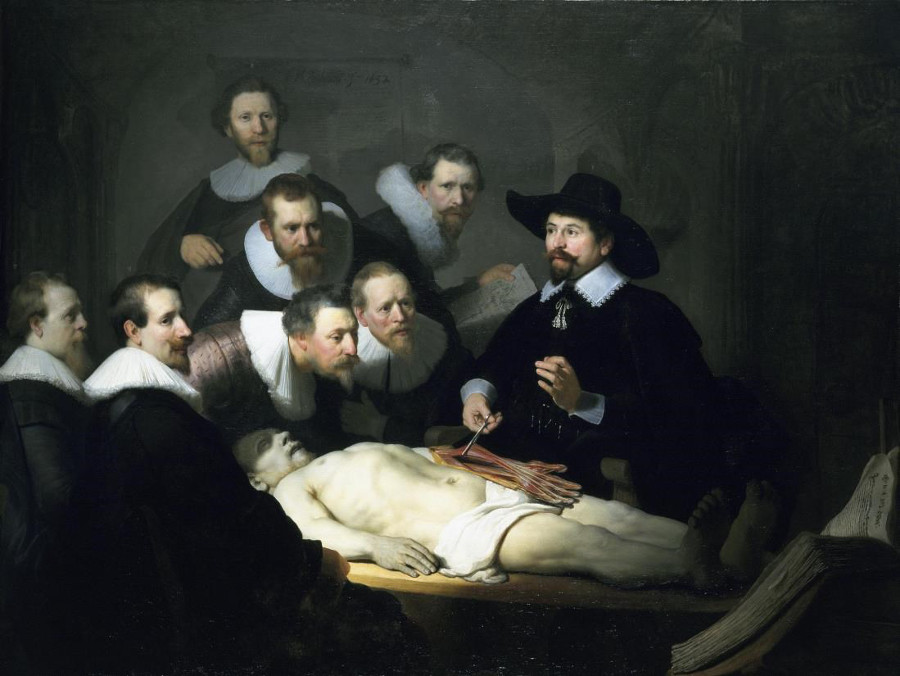
505. Anatomy of Professor Tulp. (The Hague.)
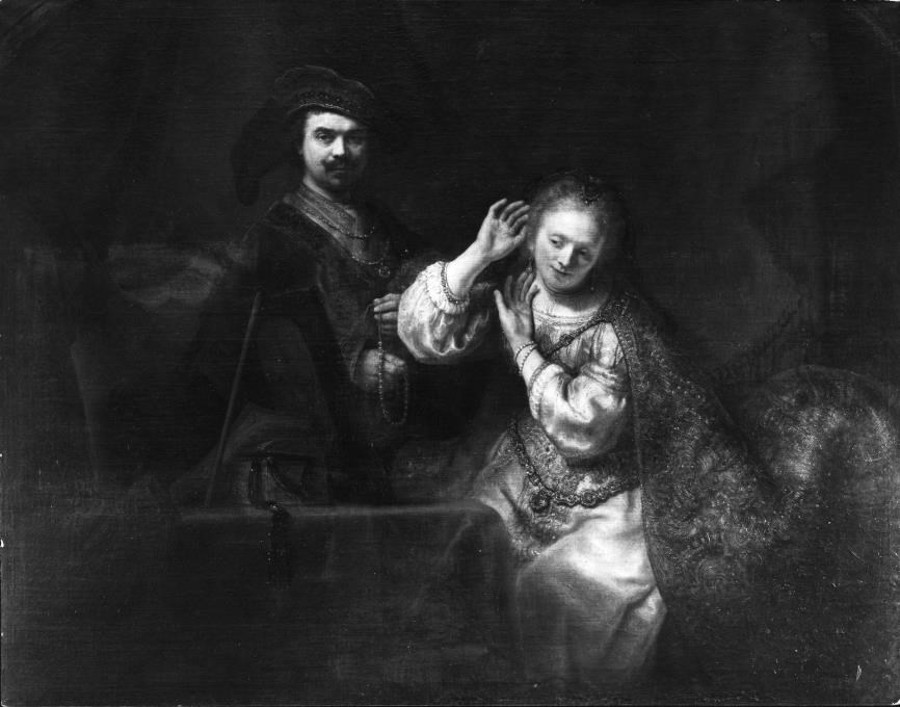
506. Rembrandt and Saskia
Here we have a picture
of Rembrandt and his wife; they are both looking into a mirror:
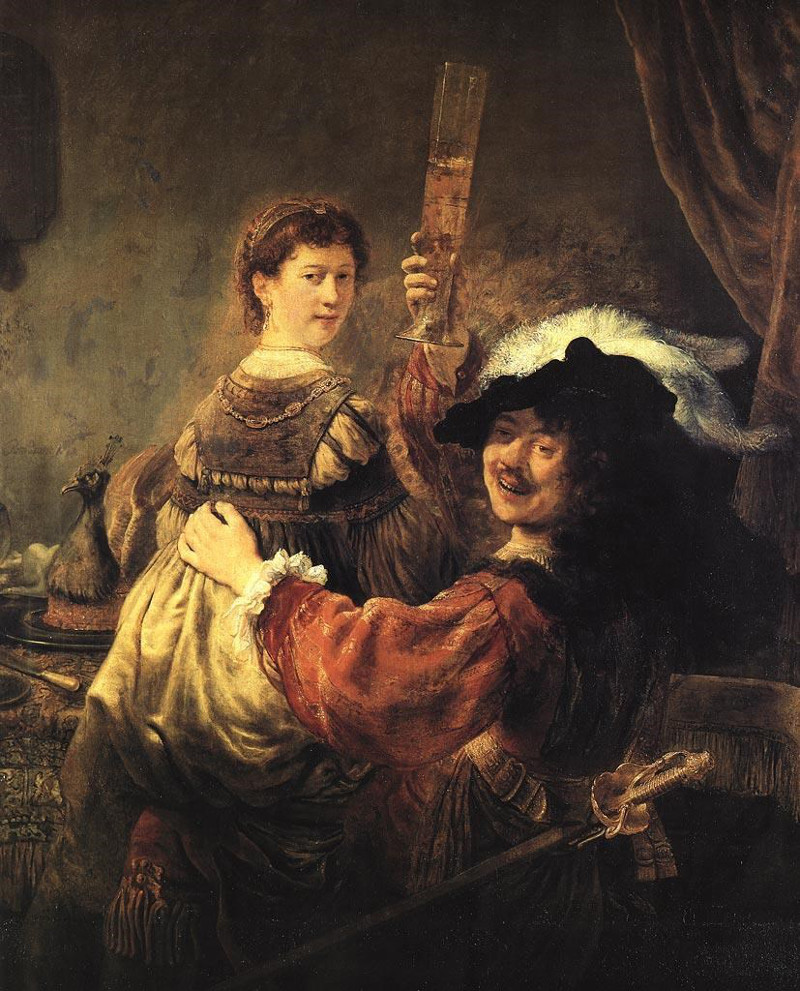
507. Rembrandt with Saskia on his lap. (Dresden.)
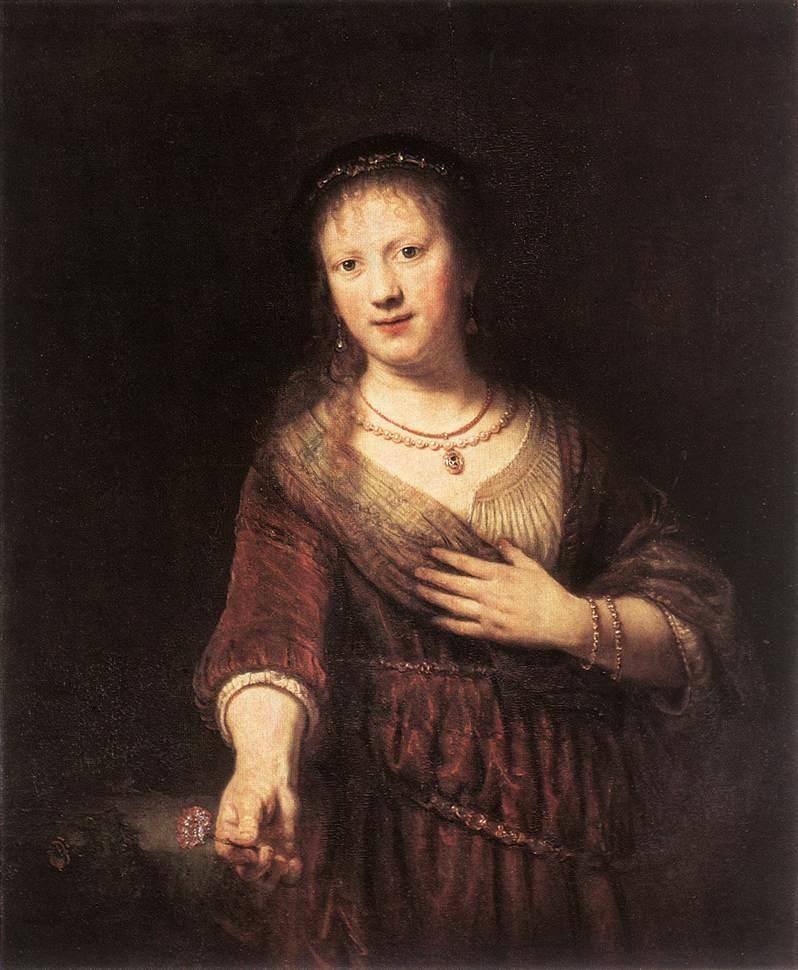
522. Saskia with the red flower. (Dresden.)
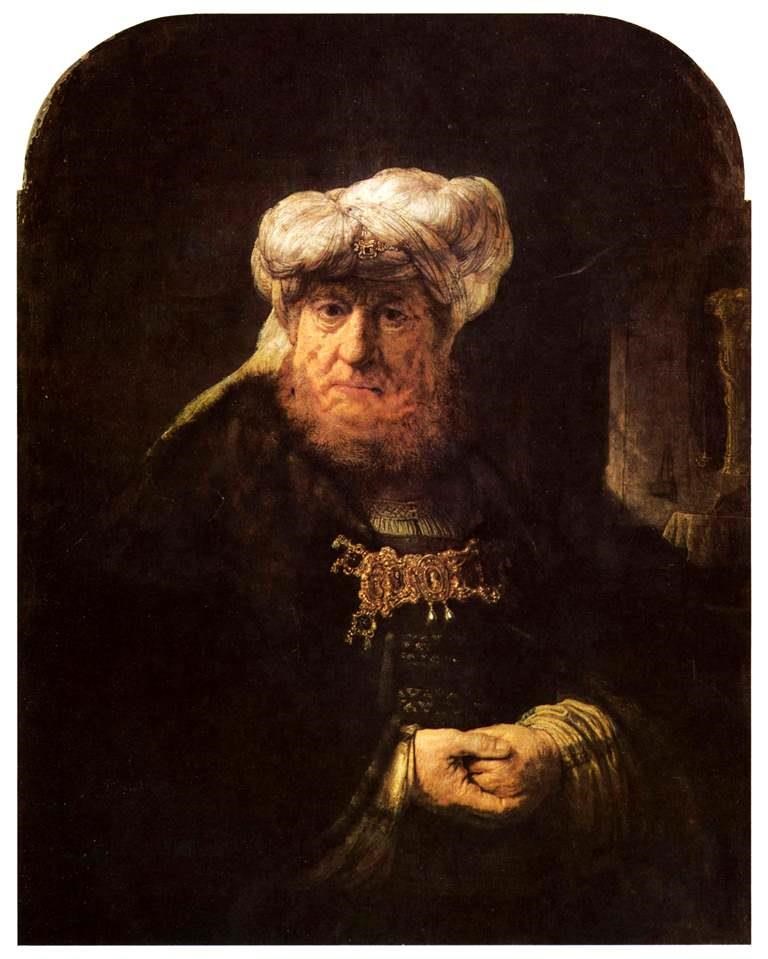
508. Oriental with a Turban. (Prague.)
It is interesting to hear
of an experience which Hermann Grimm relates. He introduced the use of
Lantern-slides in University lecturing. It is evident on other occasions,
also, how much can be gained from the use of lantern slides and projectors
in familiarising ourselves with the world of Art. But once when Hermann
Grimm was lecturing on Rembrandt, the slides arrived a little late. He had
not time to go through them beforehand, and saw them for the first time
during the lecture, which thus became a kind of running conversation
with his hearers, among whom there were always older people as well
as students.
Now I need scarcely remind
you that in lecture halls, which are generally well lighted, a more
or less wide-awake attention prevails — occasionally more, generally
less: But the customary condition was changed in as much as the hall
was darkened. And through the darkness and the effect of the Rembrandt
pictures thrown upon the screen, people in the audience again and again
had a peculiar impression, as Hermann Grimm himself relates. In effect,
through the extraordinary vividness which Rembrandt can achieve, one
really has the feeling that such a character is present here, among
the people in the room. He is there — and if you imagined all
the paraphernalia removed — if there were only the light-picture
by itself — it would be all the more vivid. The number of people
in the room is simply increased by one, so vividly does this figure
live among us.
Rembrandt attains this effect
because he places his figures into that element in which man always
lives — though he is unconscious of it — the element of
light and dark. This light and dark which is common to us all, Rembrandt
pours out over his figures, and so places them into this living interplay
of light and darkness, thus endowing them with a common element —
in which the onlooker himself is living. That is the wonderful thing
in Rembrandt.
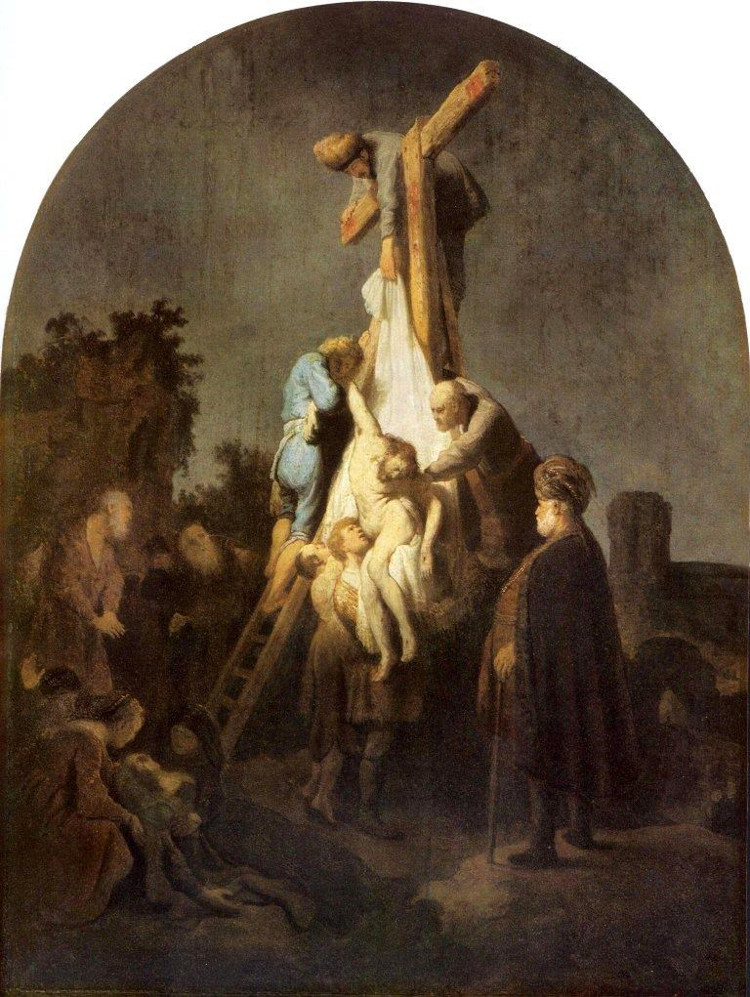
509. Descent from the Cross. (Alte Pinakothek.
Munich.)
Here you see there is a
decided attempt at a composition. Yet the composition, as such, it must
be admitted, is not a great success; at any rate it is by no means equal
to what is called so in the Southern Art. But look at the characteristic
Rembrandt quality once more. Infinite mysteries speak to us out of this
picture, simply through the distribution of the masses of light. The
composition is truly not very great, and yet I think the picture makes
an extraordinary deep impression upon us.
I should really have shown
the next two pictures before this one, but I have purposely chosen the
reverse order. I beg you to compare this picture with the two next,
which most probably preceded this one in time. There is probably an
interval of about two between this picture and the next but one. Showing
the pictures in the reverse order, I wish to illustrate how Rembrandt
perfected himself. He was constantly wrestling and striving. Compare
this picture with the next but one — that of the Ascension —
and you will see how he advanced. Compare them with respect to depth
and inwardness. The next is the Resurrection.
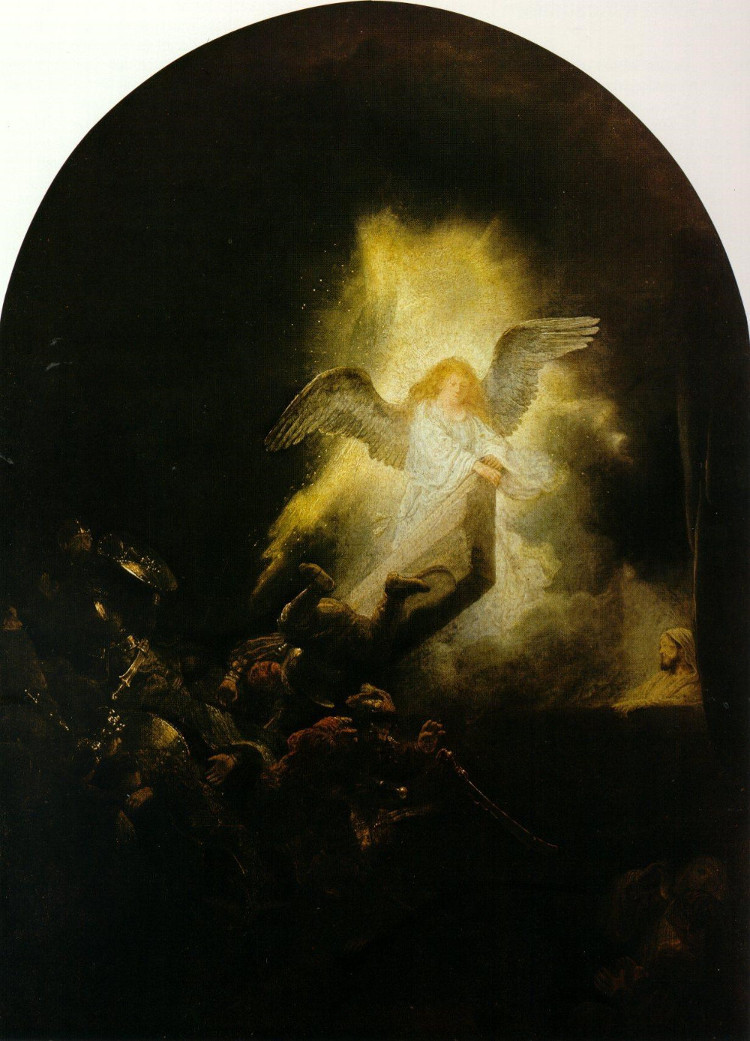
511. The Resurrection. (Munich. Alto Pinakothek.)
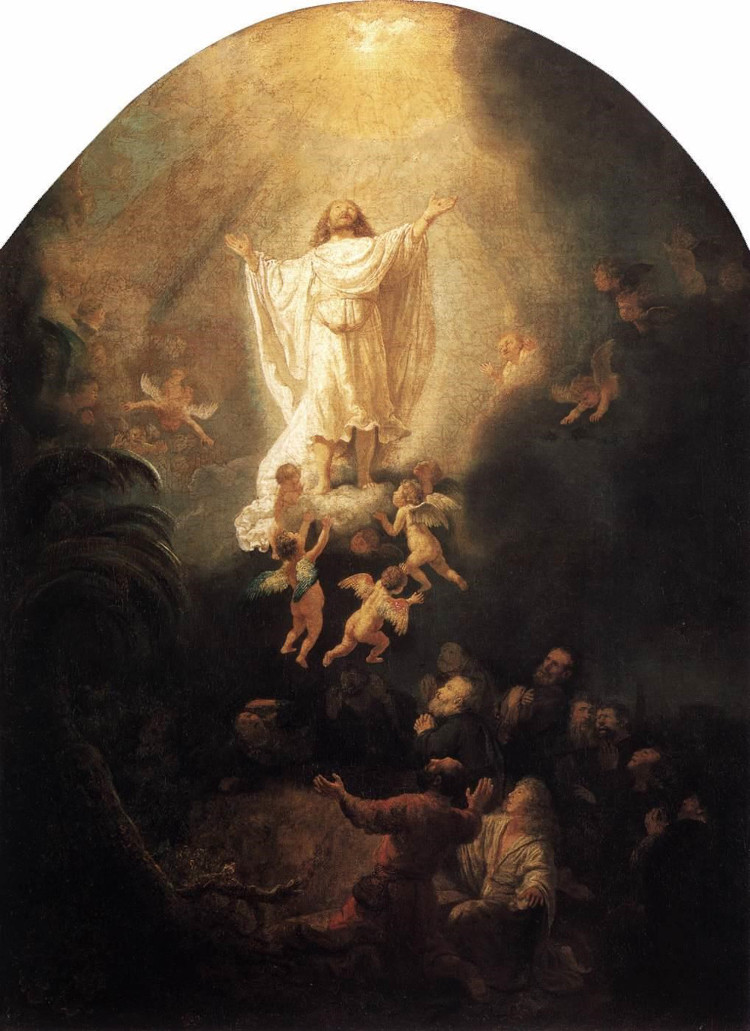
512. The Ascension of Christ (Munich. Alto
Pinakothek.)
And now we come to:
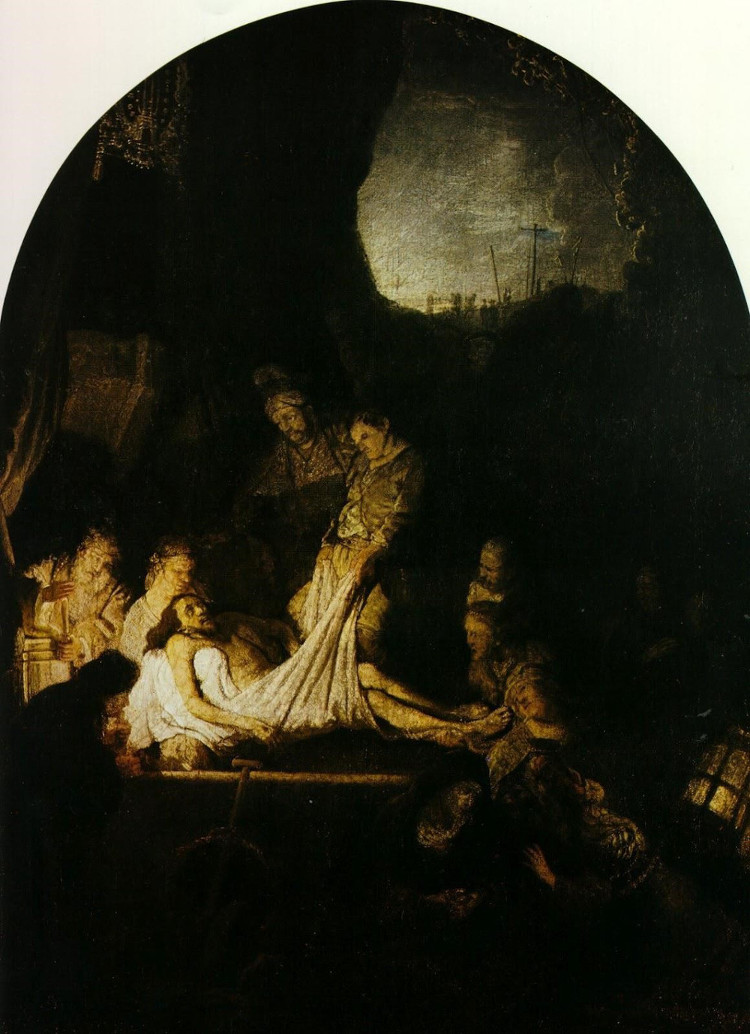
510. The Entombment. 1639. (Alte Pinakothek. Munich.)
With the
“Entombment,” which undoubtedly represents a considerable
advance on this, we come near the year 1640 — or, at any rate,
the close of the 1630s.
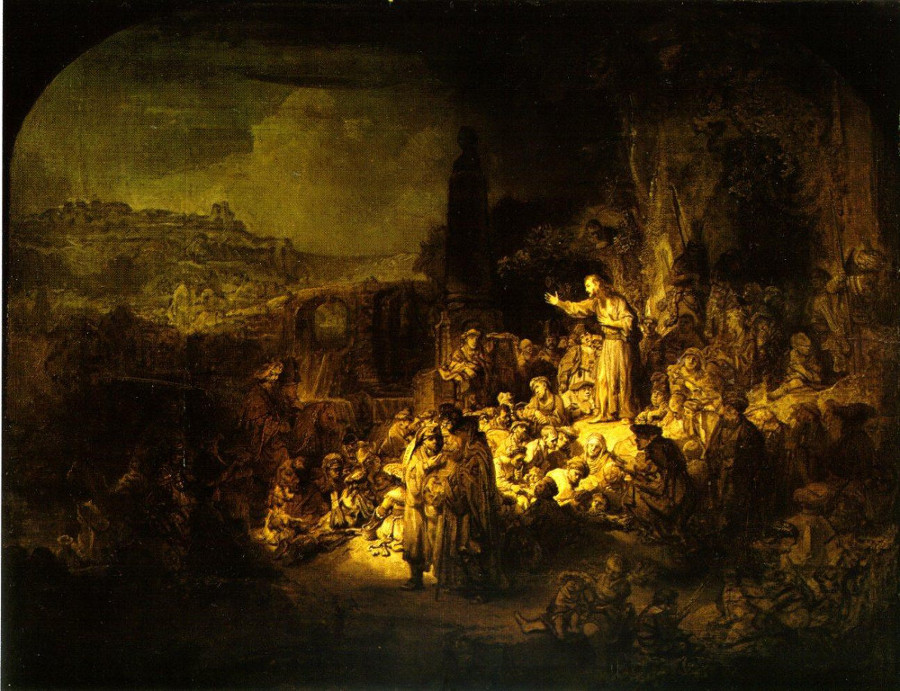
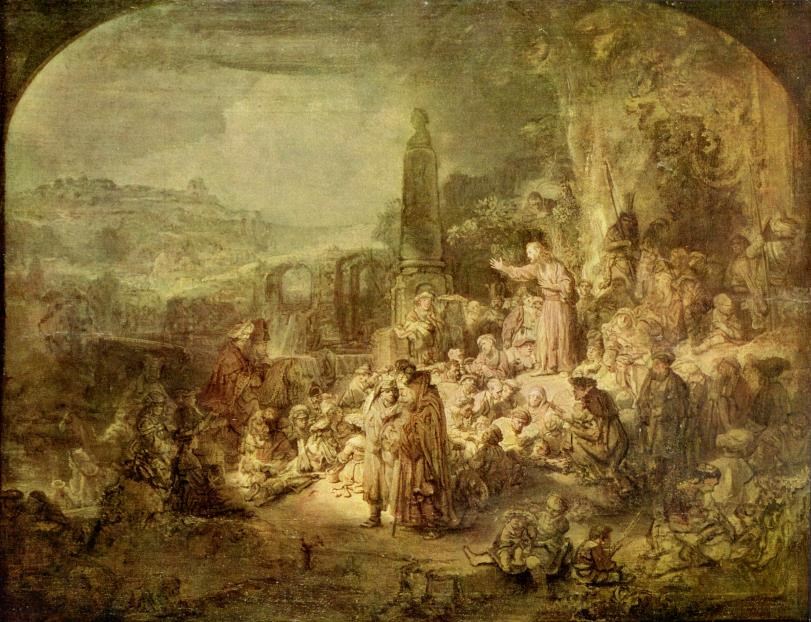
513. Sermon of John the Baptist. (Berlin.)
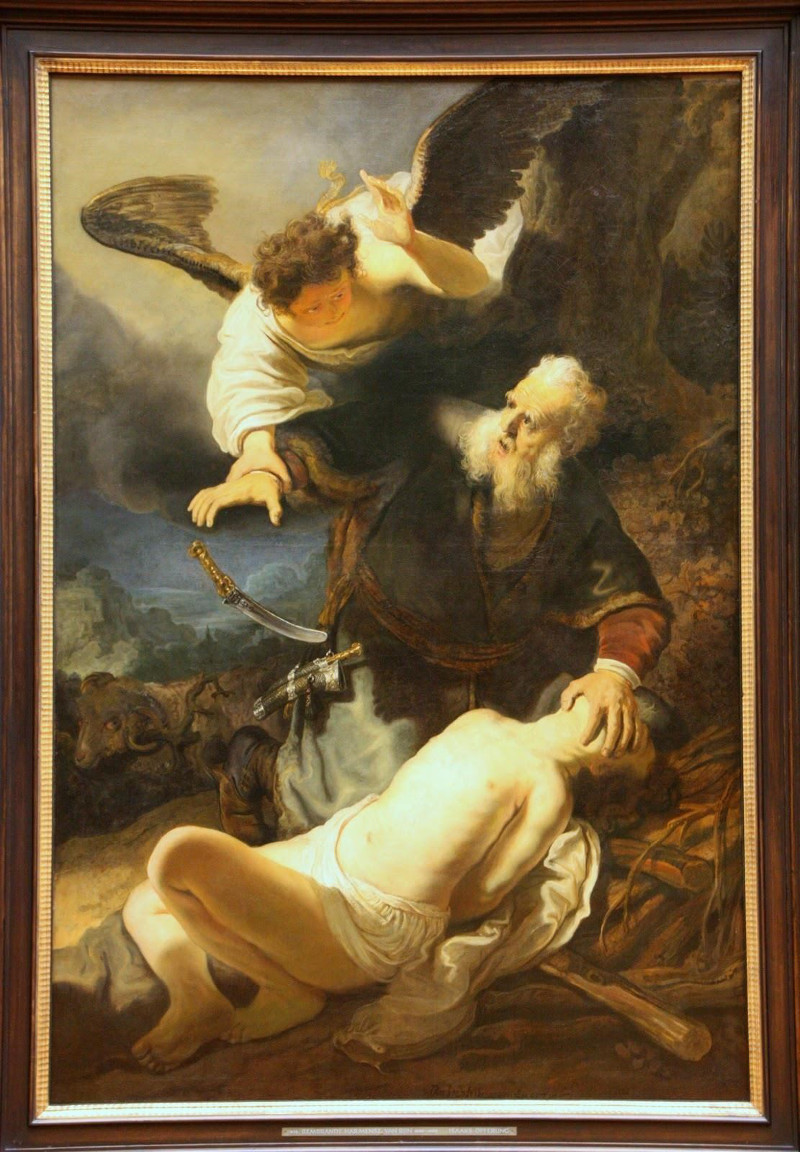
514. Abraham's Sacrifice. (Eremitage. St. Petersburg.)
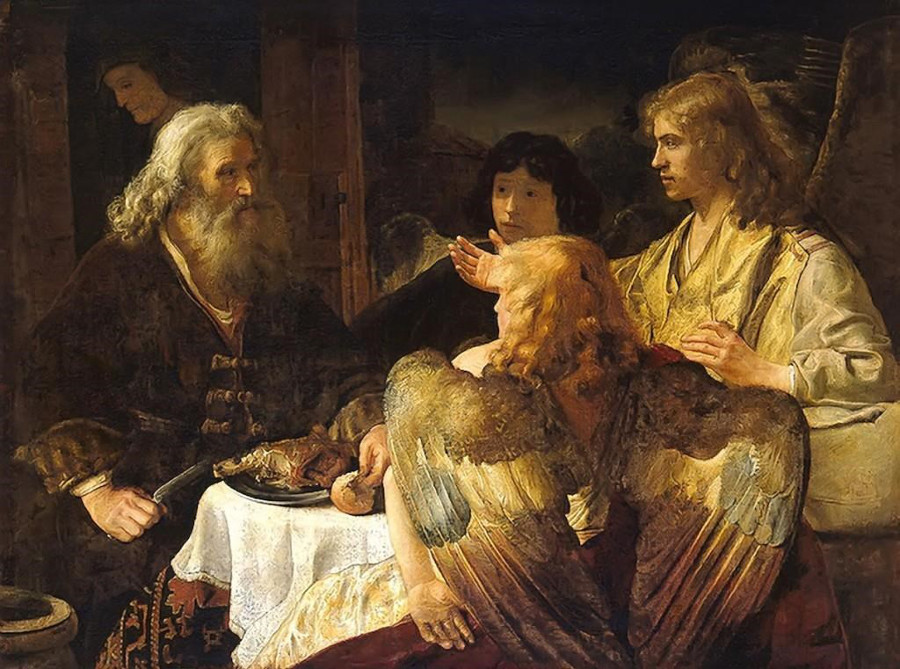
515. Abraham and Three Angels. (Eremitage.
St. Petersburg.)
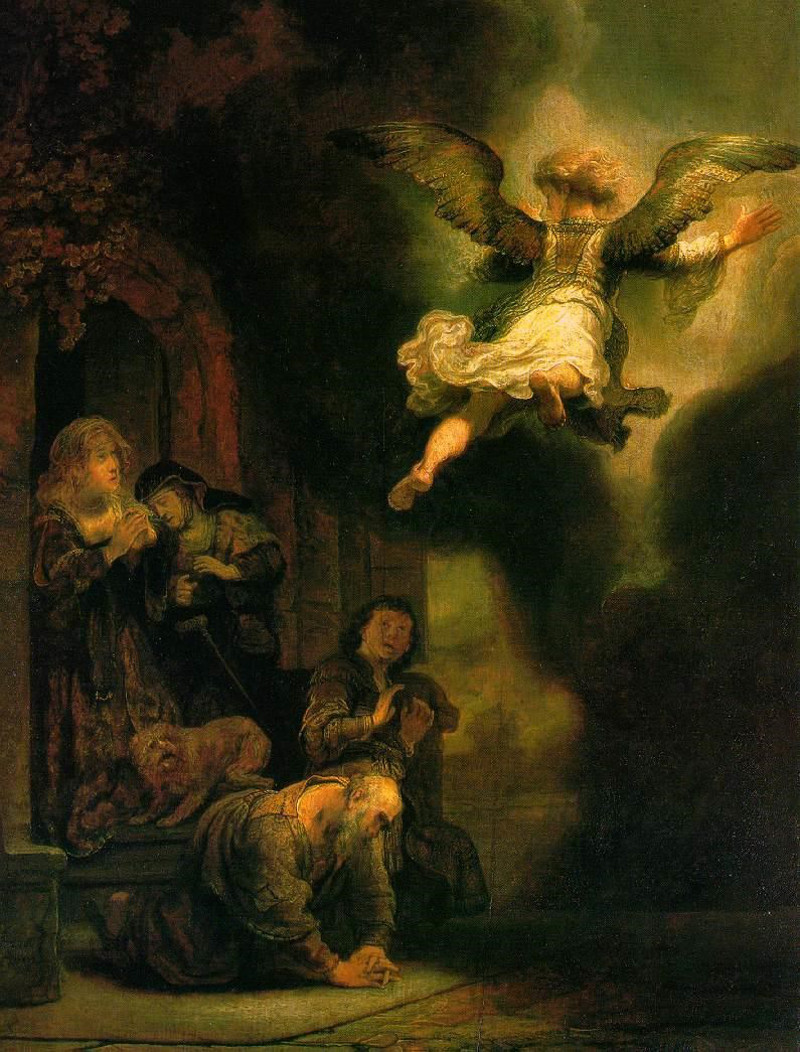
516. The Archangel Raphael leaving Tobias. (Louvre.
Paris.)
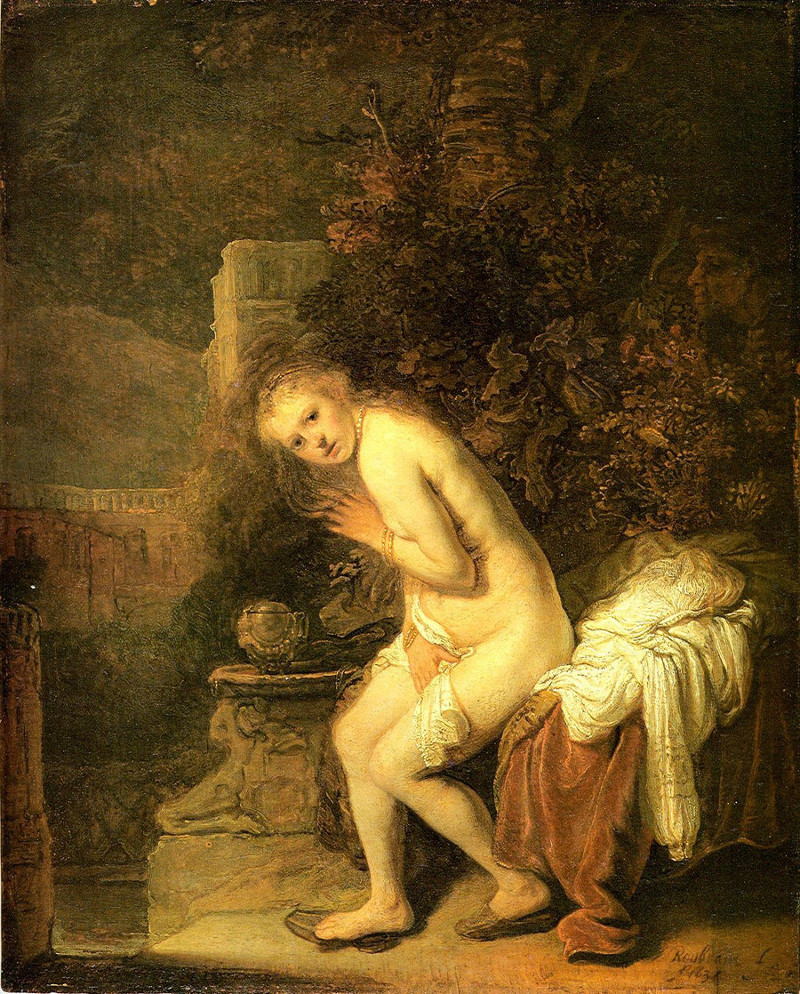
517. The Chaste Susanna.
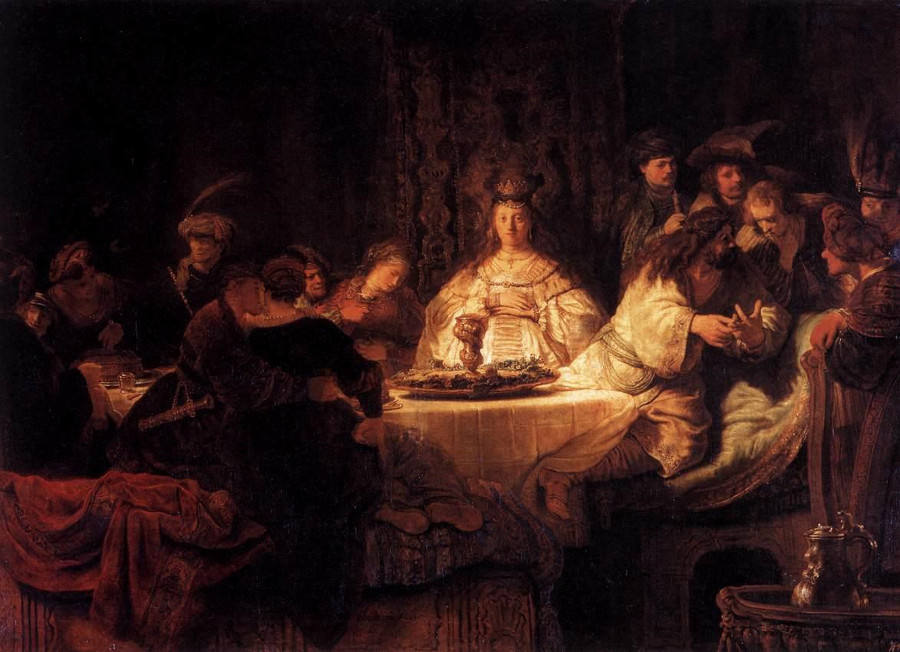
520. The Wedding of Samson. (Dresden.)
Now for an example of a
landscape by Rembrandt:
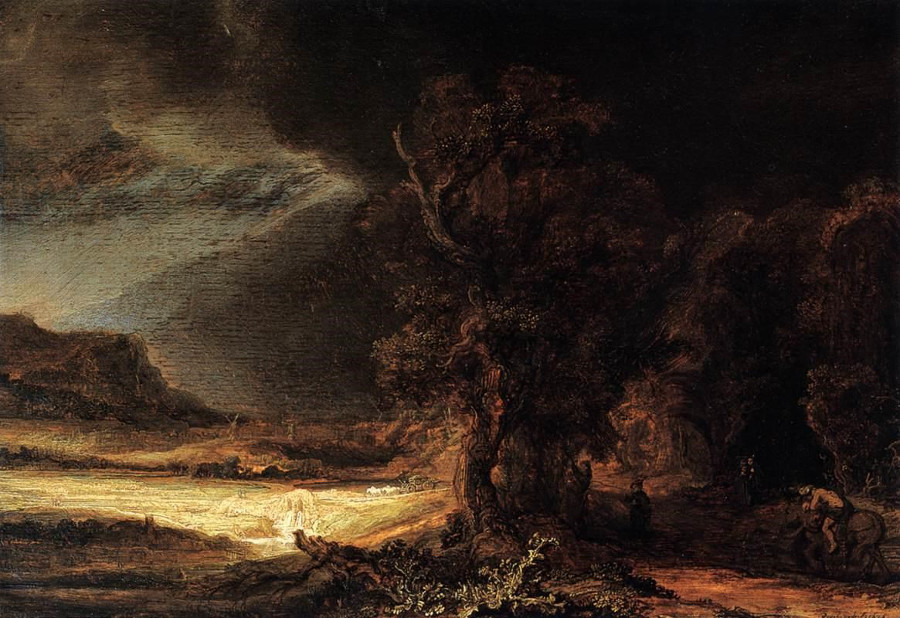
518. Landscape with the Good Samaritan.
(Kraków.)
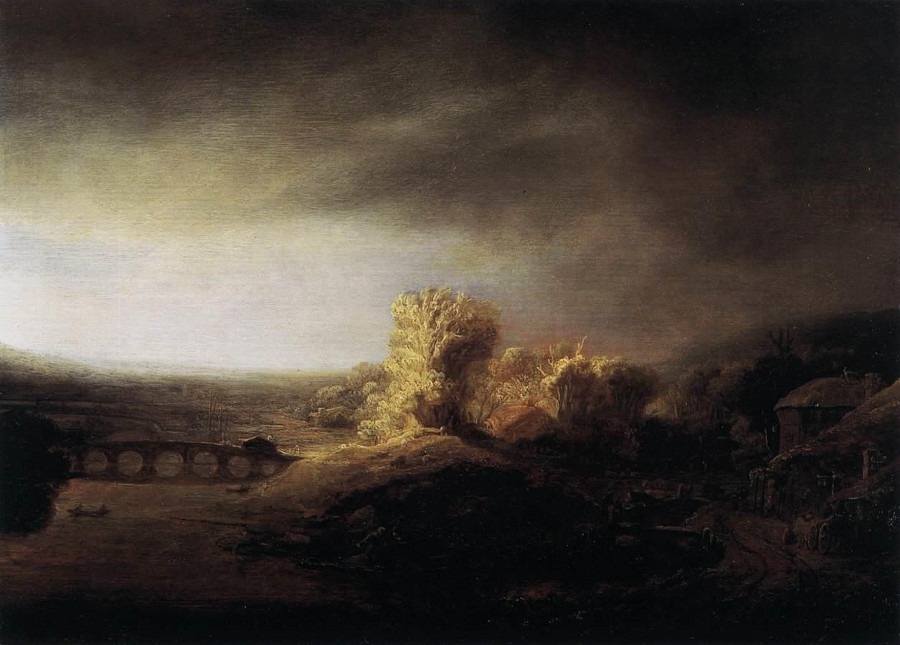
519. Landscape with the Arched Bridge. (Berlin.)
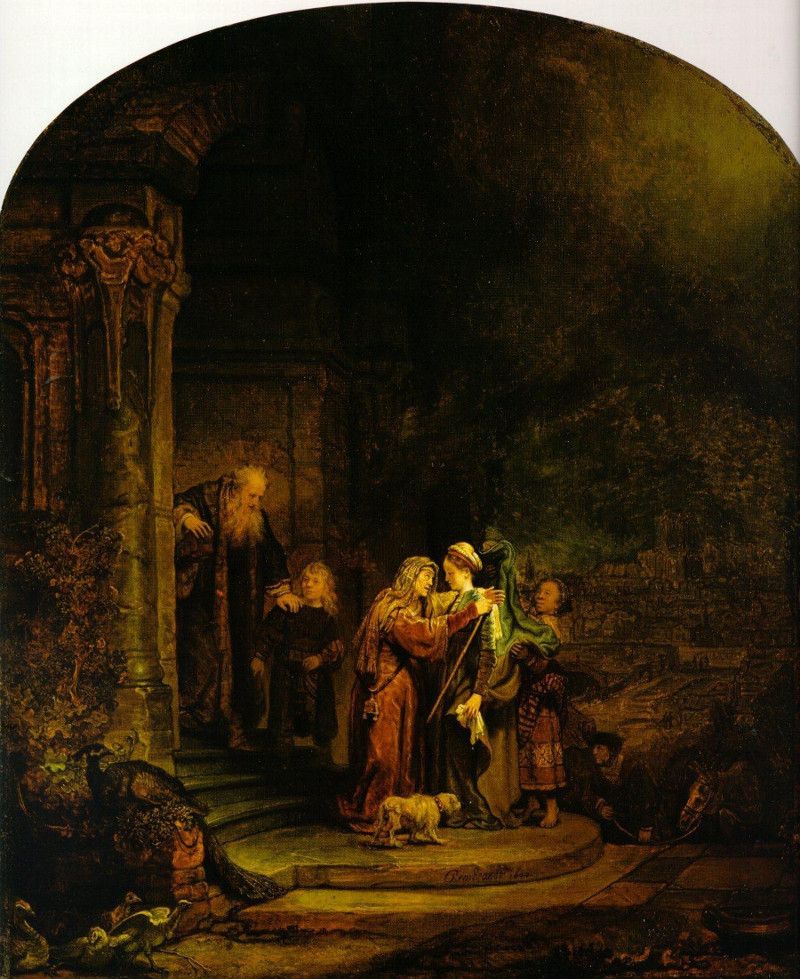
521. The Visitation of Mary (Detroit.)

522. Saskia with the red flower. (Dresden.)
And now we come to some
of the most famous of his pictures:
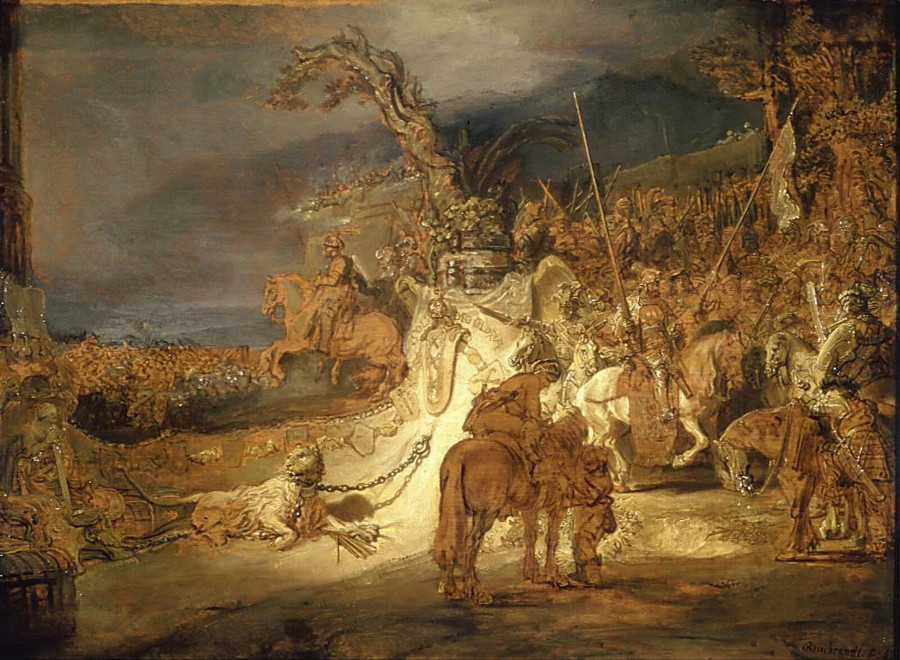
524. Allegory of the Peace of Westphalia. (Rotterdam.)
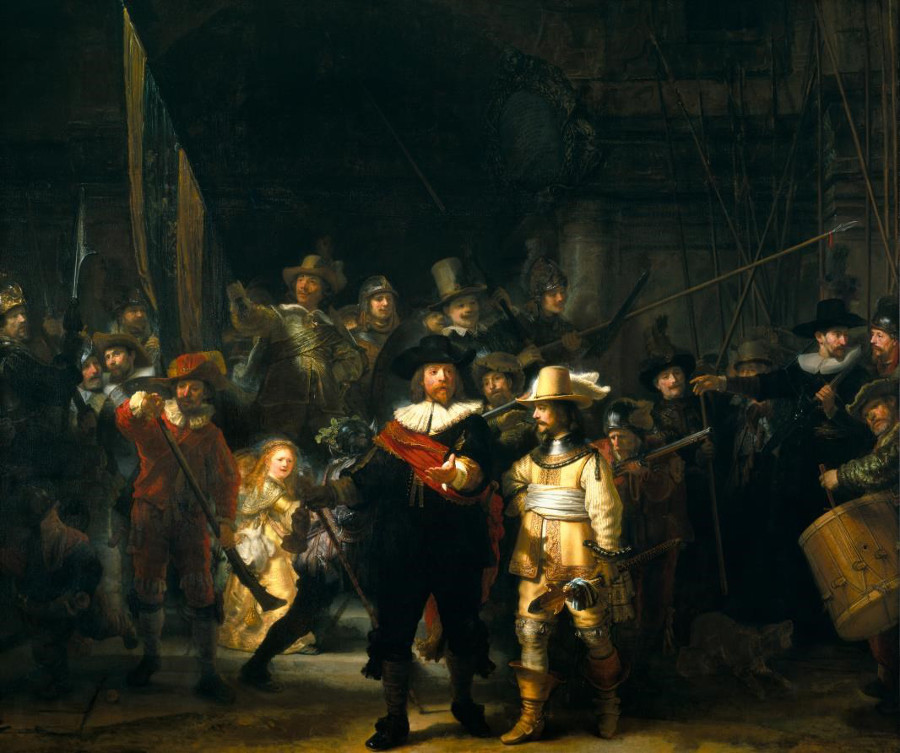
525. The Night Watch (Amsterdam.)
The Amsterdam Citizen's
Guard gathered round the drummers in the night — a whole host
of individual figures. Rembrandt was not the only artist of his time
to paint such pictures as this. Only he did so with an unique perfection.
Such a picture shows us especially how this artist is rooted in the
people. Look at this whole collection of men. Some Guild or other —
people of one and the same class or calling, men who belonged together
— ordered the picture jointly; each one paying his share. This
man here, of whom only half the head is visible, made a great fuss.
He was very angry and Rembrandt got into trouble because he did not
find himself portrayed in his full glory.
“The Night Watch”
shows us in the most beautiful way how Rembrandt had progressed. Look
at the wonderful distribution in this picture of the light and darkness.
This is, indeed, the very time of the great deepening of Rembrandt's
life. The picture dates from 1642, the same year that he lost the wife
whom we saw in the portrait just now, and in the portrait of the two
together.
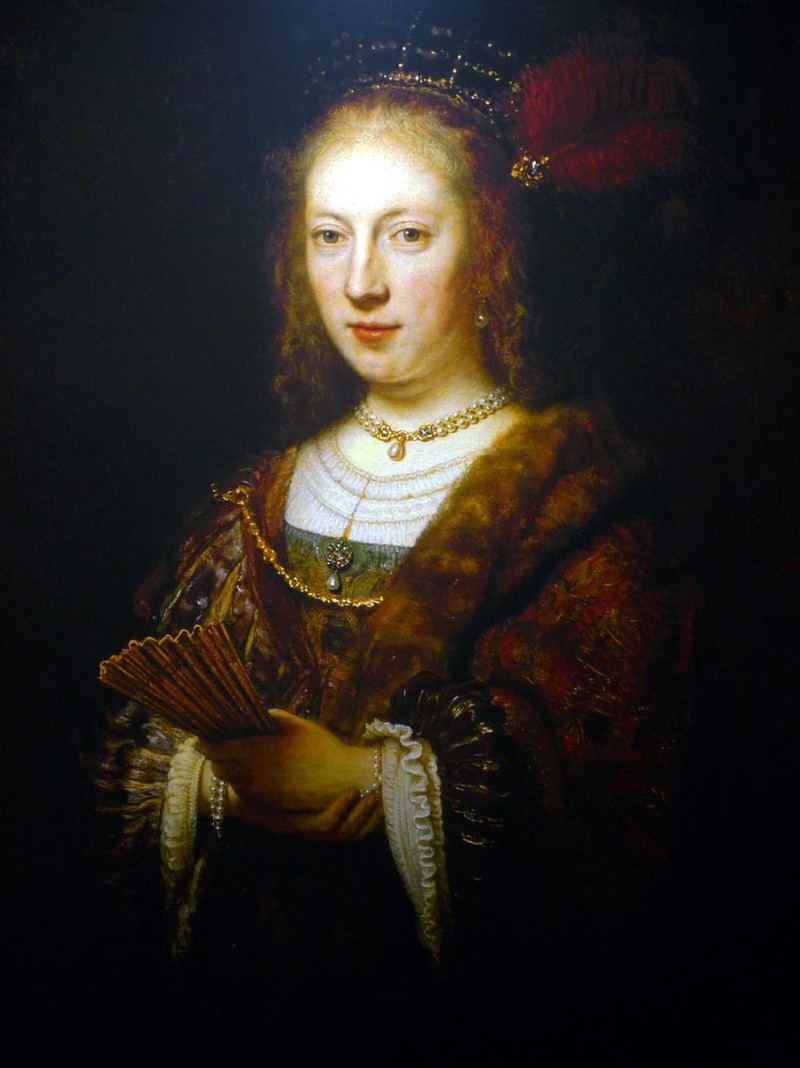
523. The Lady with the Fan. (London.)
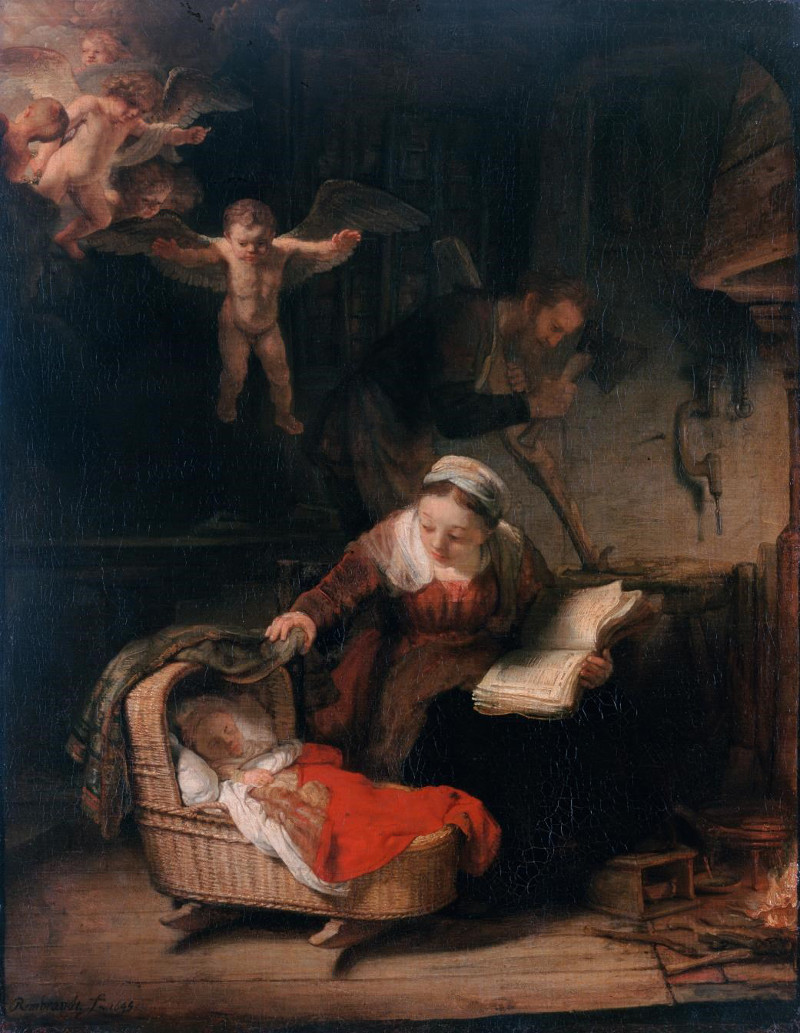
526. The Holy Family (Leningrad, Eremitage.)
I think you will feel in
these pictures a greater clarity, a more sublime quality than in the
former ones.
Now we would like to show
a series of “self-portraits”:
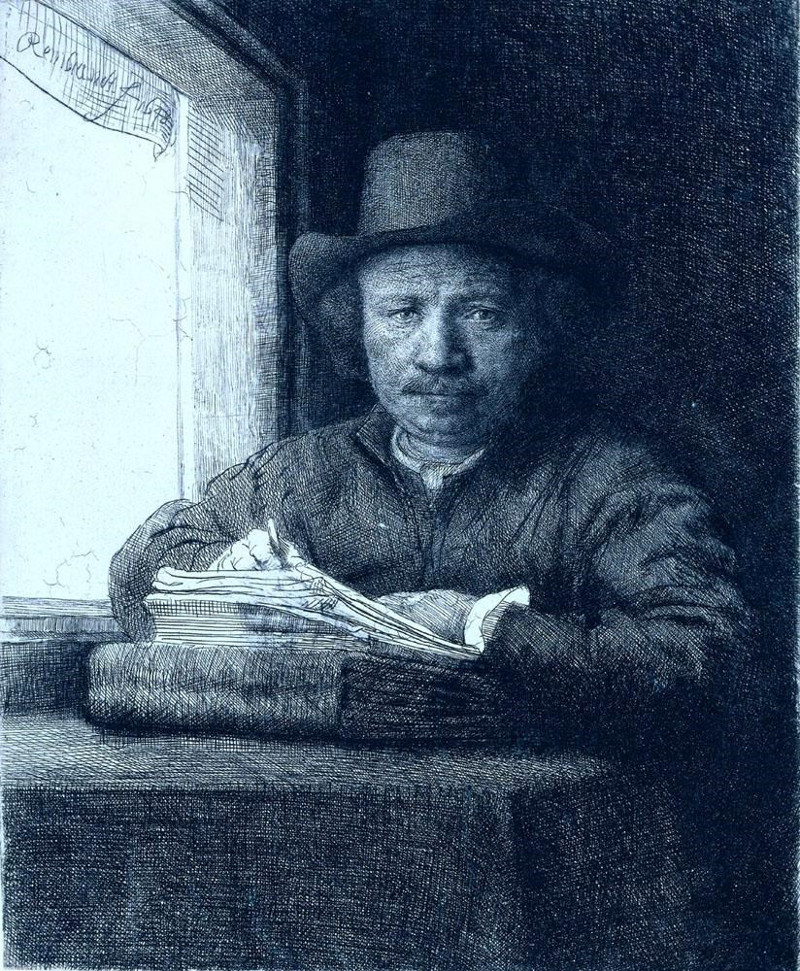
530. Self-Portrait, 1645. (Amsterdam.)
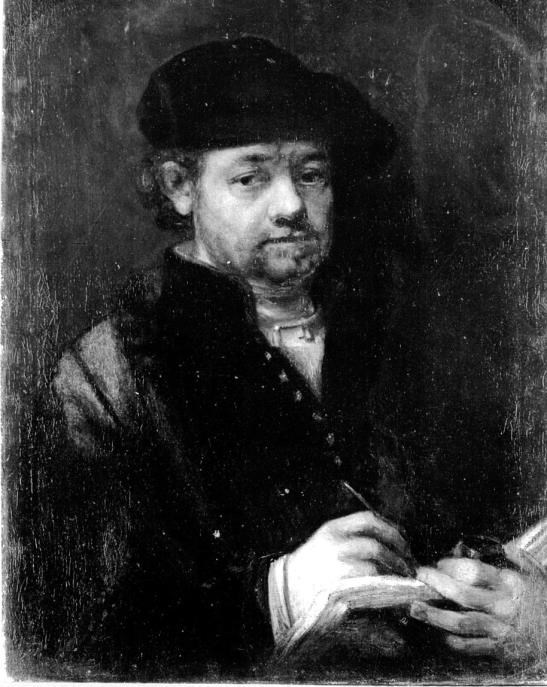
531. Self-Portrait, 1656. (Dresden.)
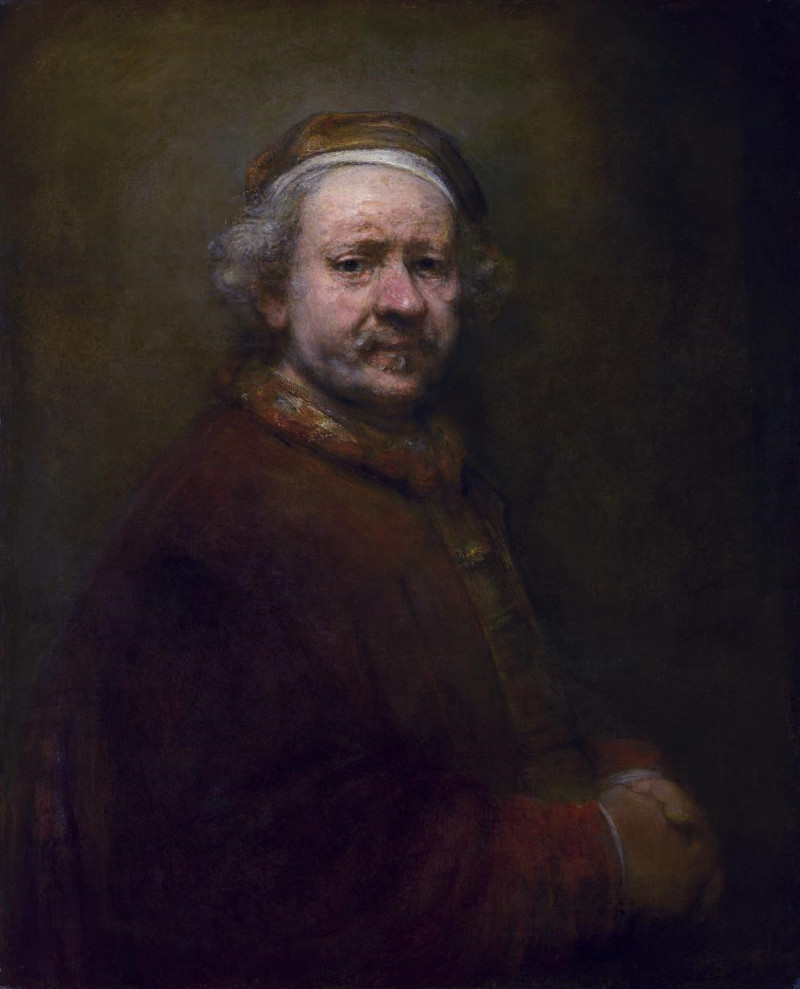
532. Self-Portrait, 1669. (London.)
Then we have an
“Adoration”:
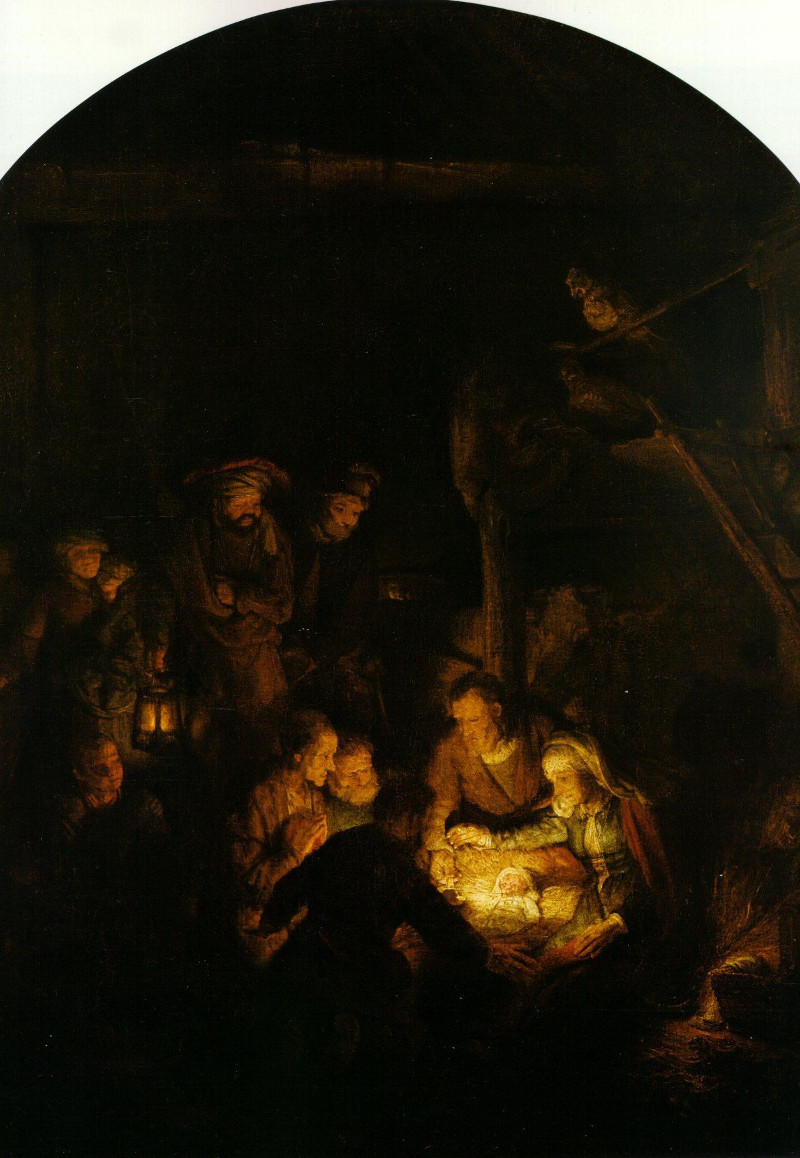
527. Adoration of the Shepherds. (Alte Pinakothek.
Munich.)
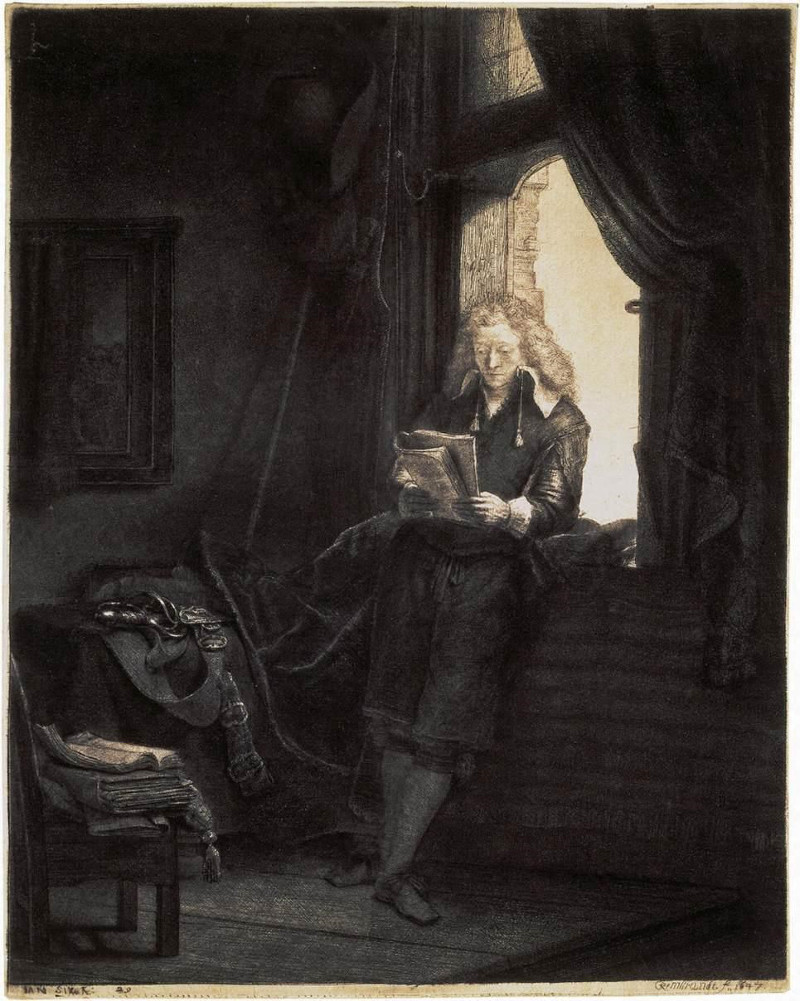
563. The Reader at the Window. (Copenhagen.)
With all its simplicity,
this is surely one of his most characteristic pictures. To show the
reader in the light, the light itself is made of the subject-matter,
as it were — the subject of the story the picture tells.
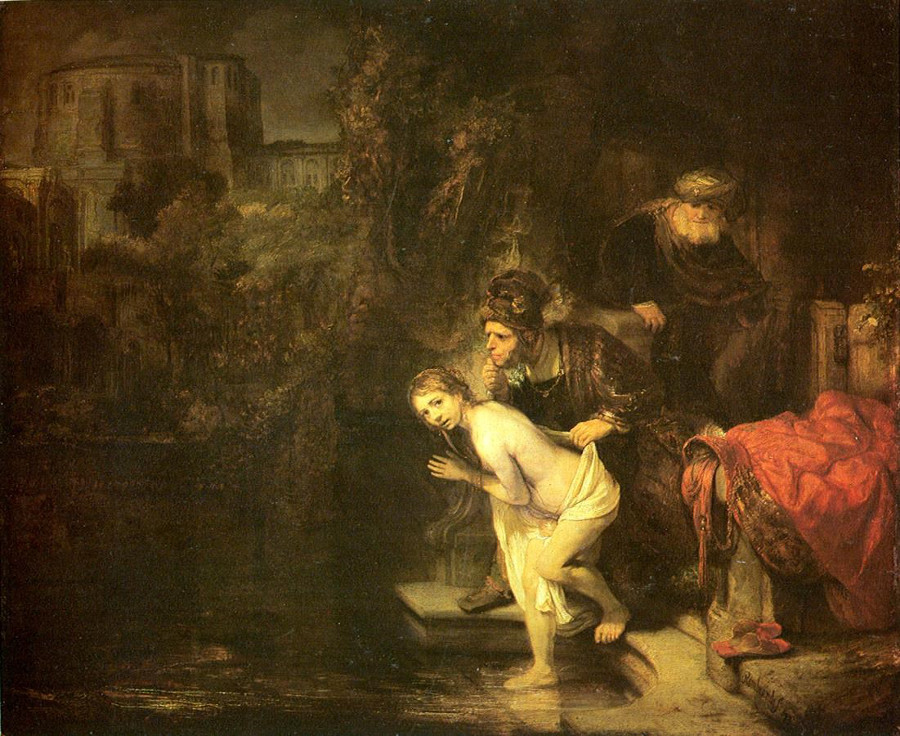
534. Susanna and the Elders. (Berlin.)
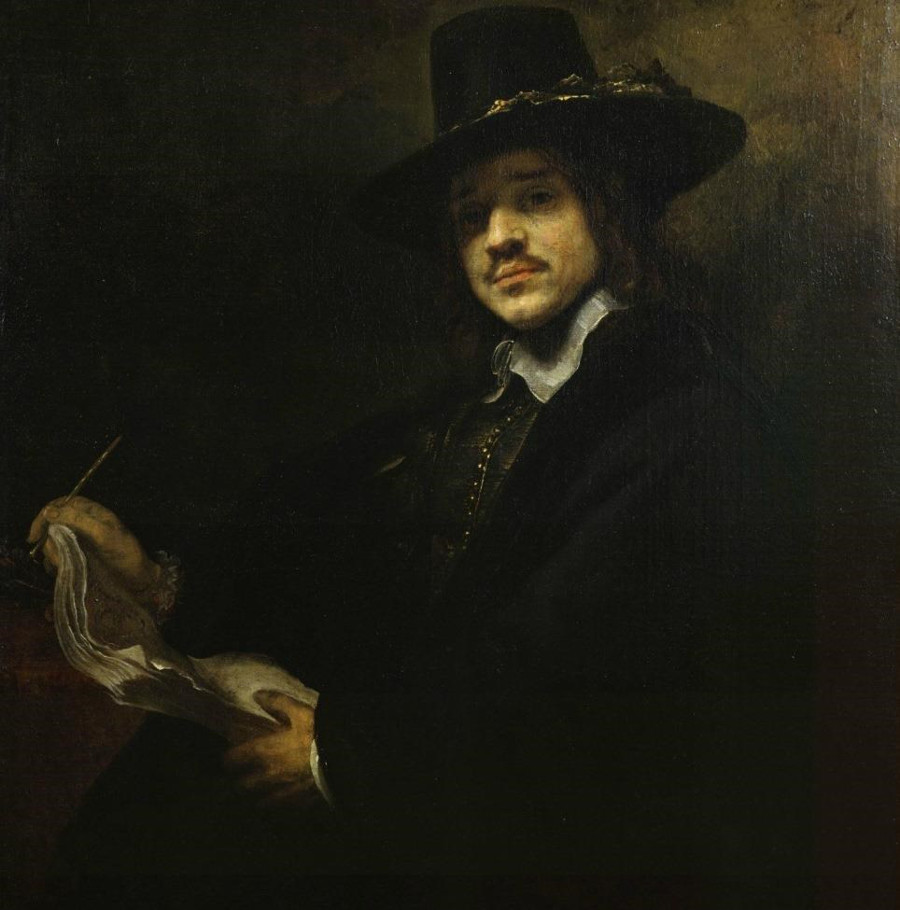
535. Portrait of a Painter (New York.)
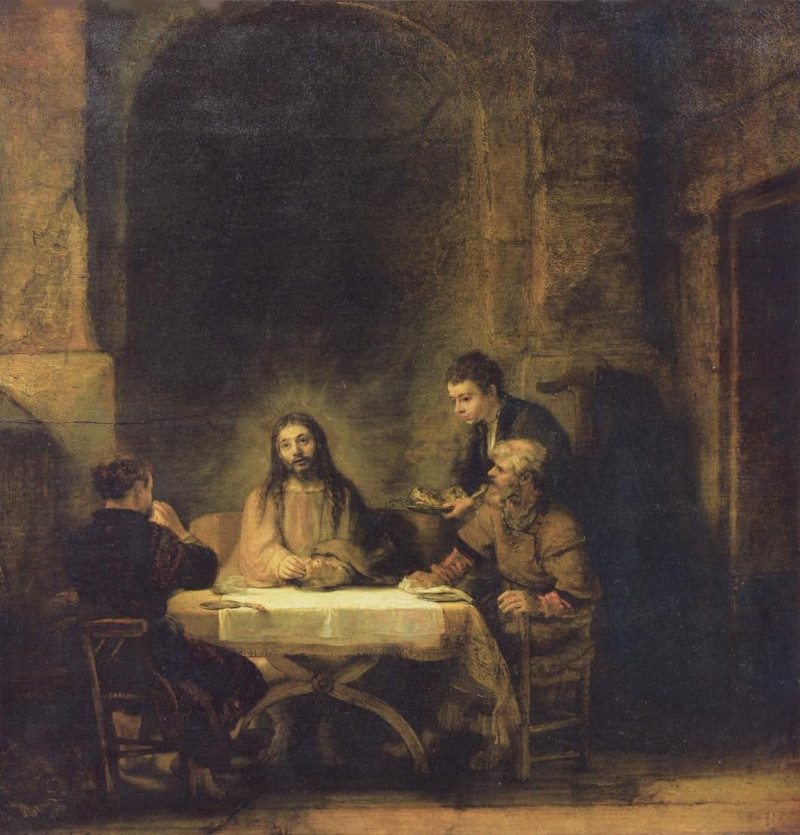
536. Christ at Emmaus. (Louvre, Paris.)
A picture of great
tenderness. We have now come to the year 1648.
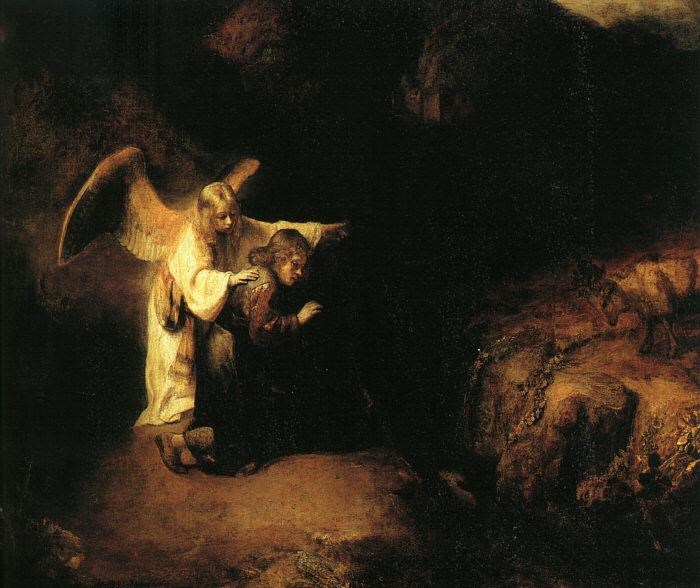
537. The Vision of Daniel. (Berlin.)
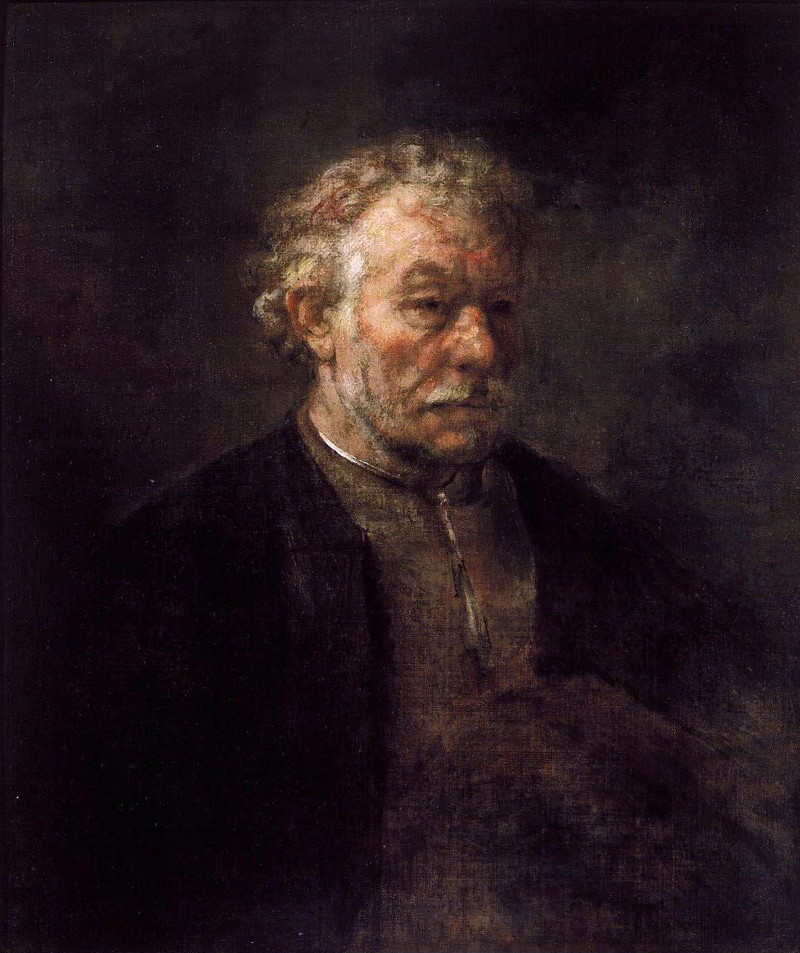
538. Rembrandt's Brother Adrian, 1650. (The Hague.)
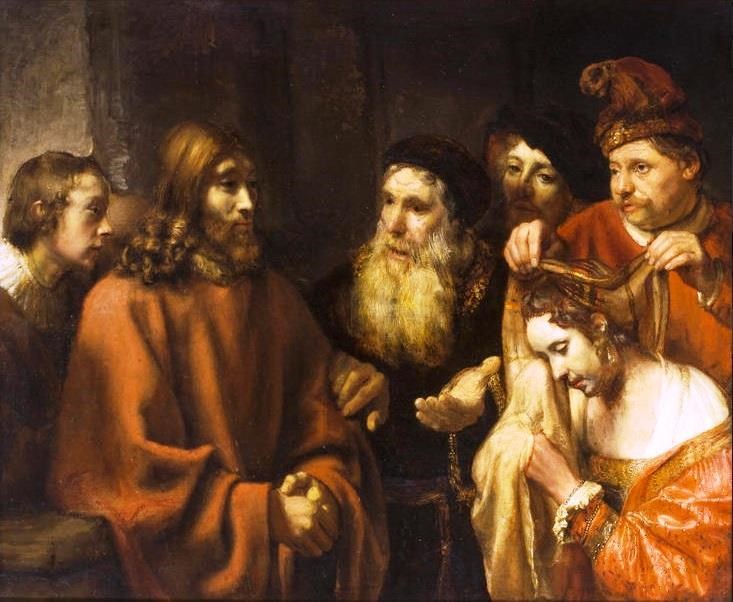
539. Christ and the Adulteress. (Minneapolis.)
I may remark that in the vast
majority of Rembrandt's pictures, the Christ is by no means beautiful.
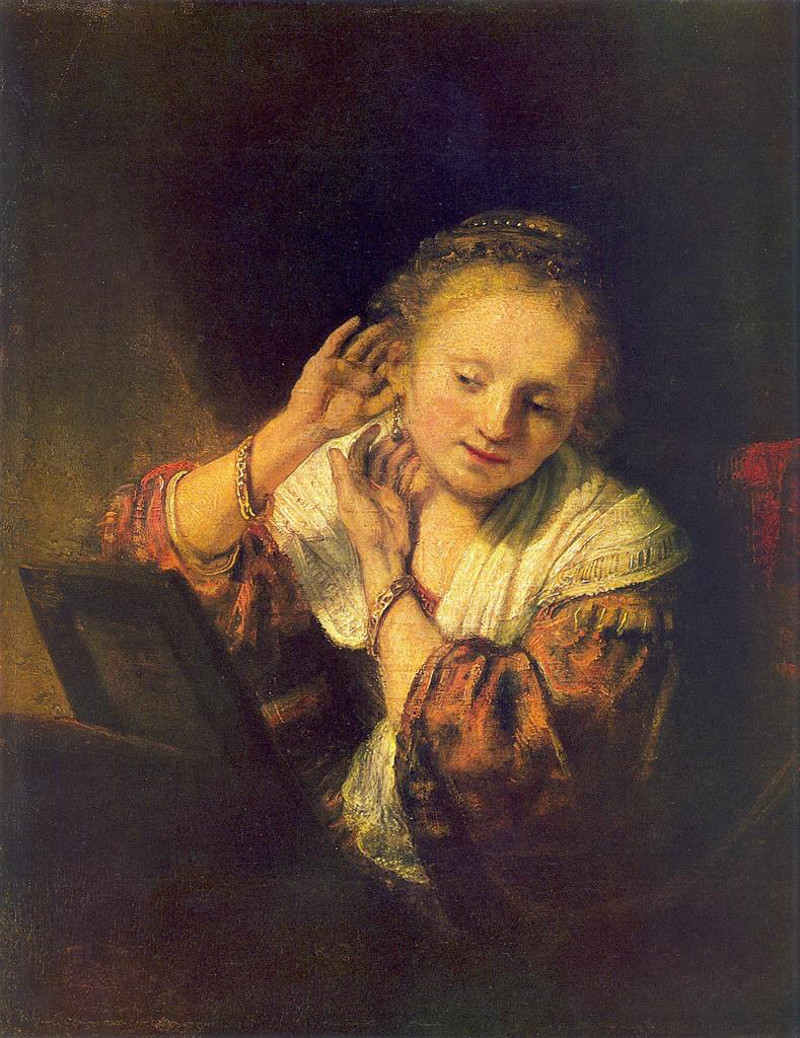
540. Young Woman in Front of a Mirror (Leningrad,
Eremitage.)
And now we come to that
most beautiful picture:
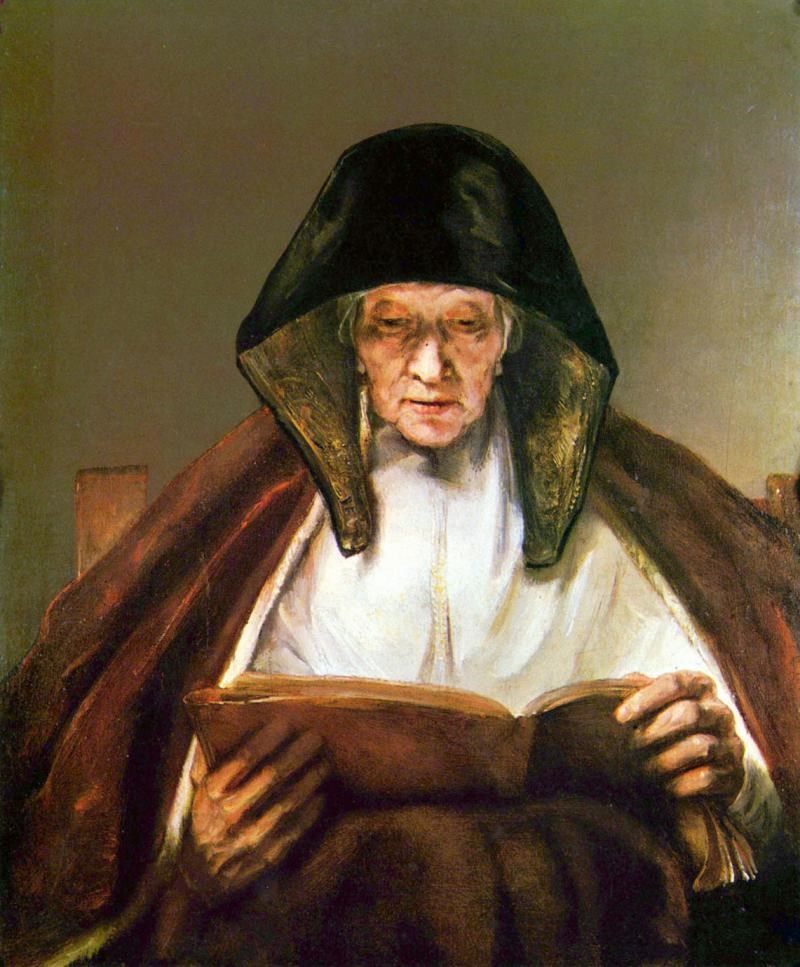
541. An Old Woman Opening a Book to Read. (Paris.)
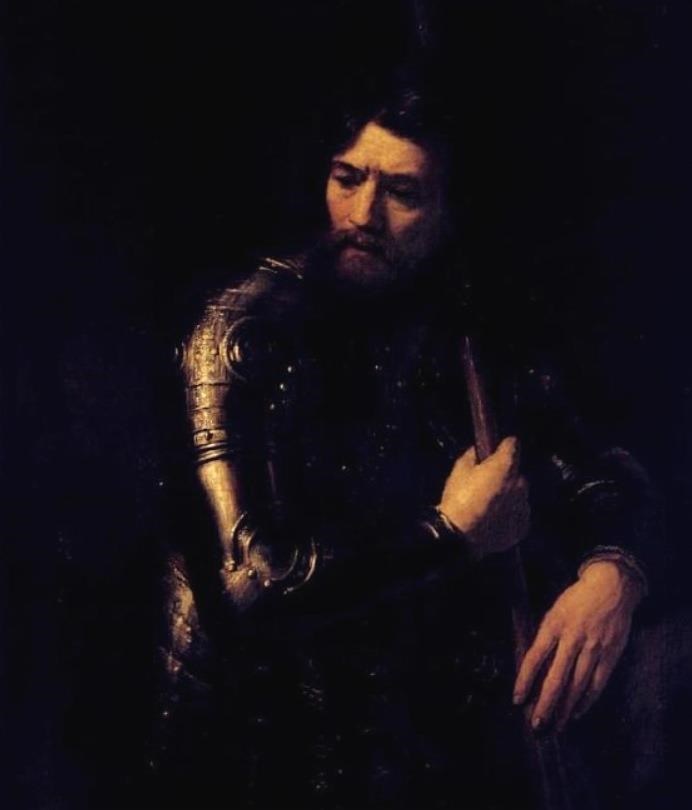
542. The Warrior in Armour. (Glasgow.)
(Rembrandt School)
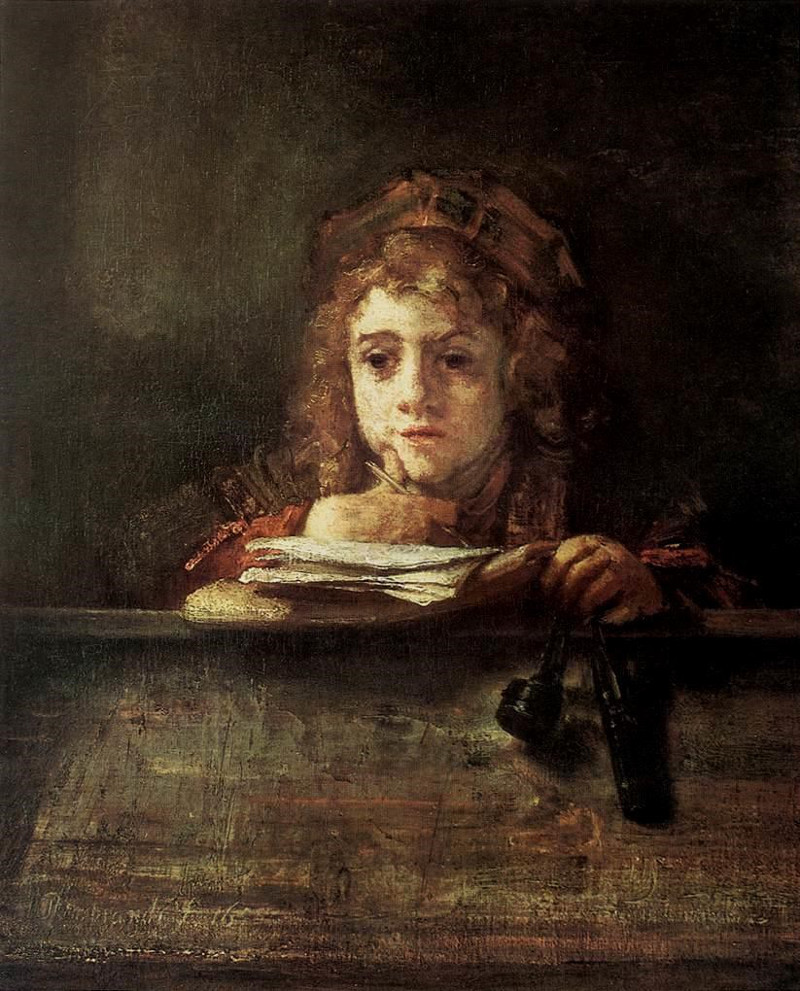
543. Rembrandt's Son Titus (London.)
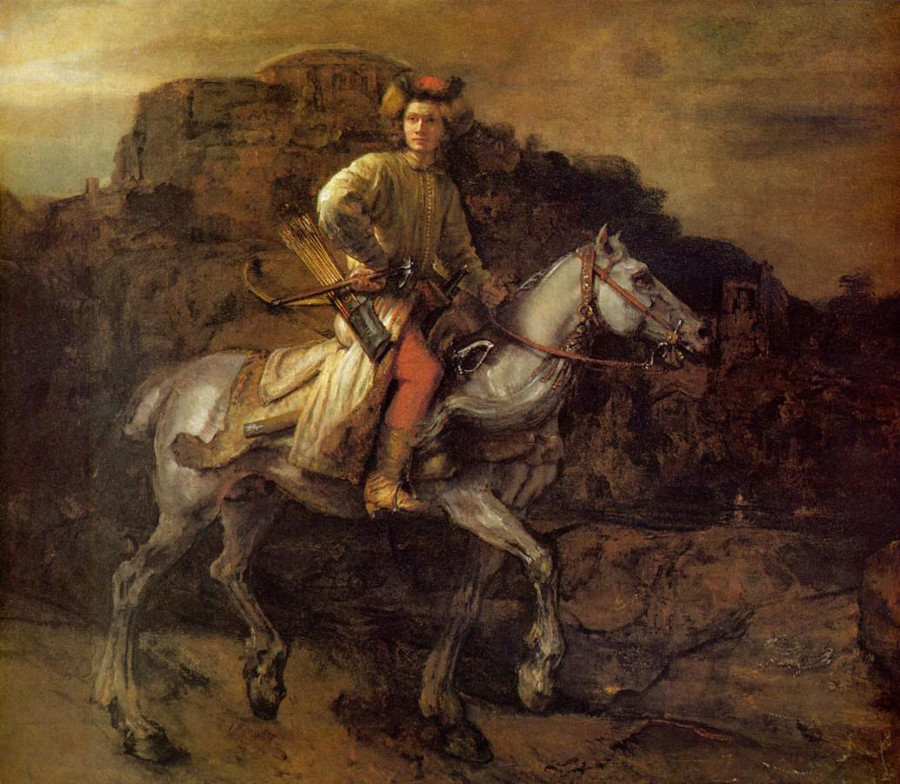
544. The Polish Rider. (New York.)
You would realise what
Rembrandt is if you could see side by side with this picture the picture
of a horse by Rubens, for example. Then you would see the whole difference
in the conception of these two pictures.
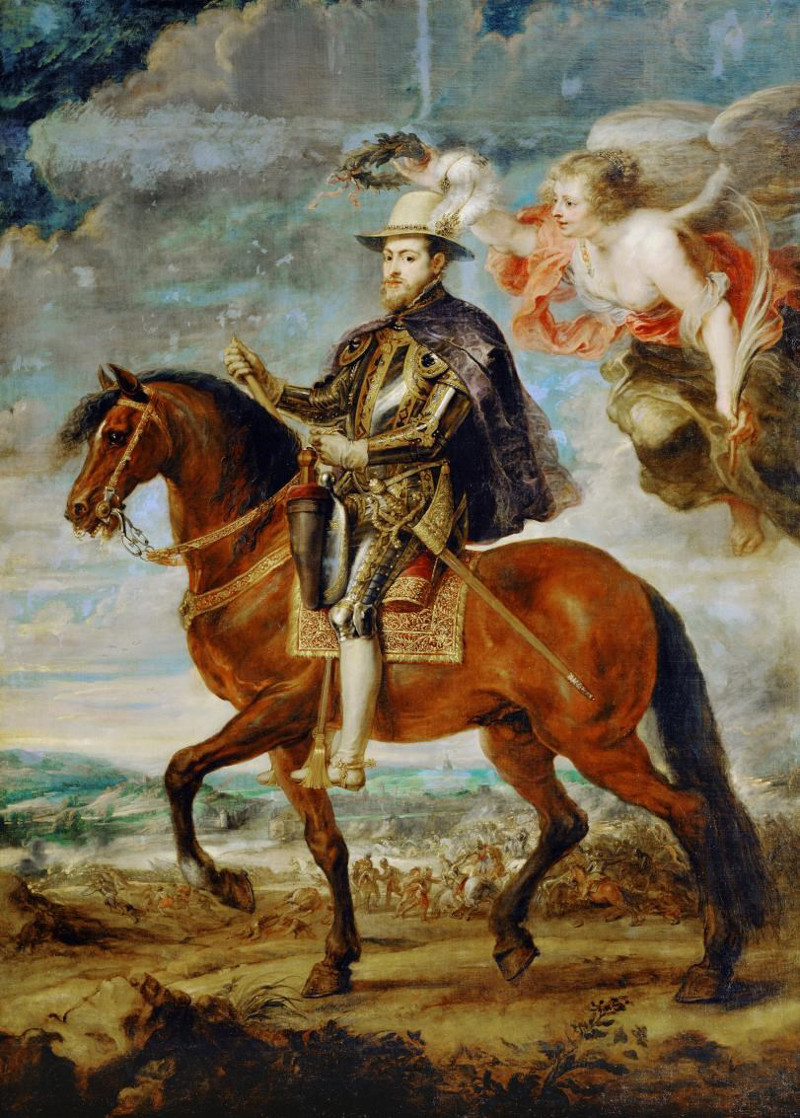
544a. Phillip II of Spain on a Horse
by Peter Paul Rubens
This horse is really moving;
it is really a living horse. No horse by Rubens, ever really moves.
Please do not think that this is unconnected with the artist's peculiar
conception out of the element of light. He who aims at what is merely
seen, he who merely tries to reproduce the “reality,” will,
after all, never be able to produce more than the frozen form. However
great his work may be, it will always contain just a little of what
we might describe as a kind of cramp, or paralysis, poured out over
the whole picture.
But the artist who holds fast
the single moment in the weaving, ever-moving element that plays round the
figures — the artist who does not work merely
“realistically,” but places his figures into the true reality
which is the elemental world — he will achieve a real impression of
movement.
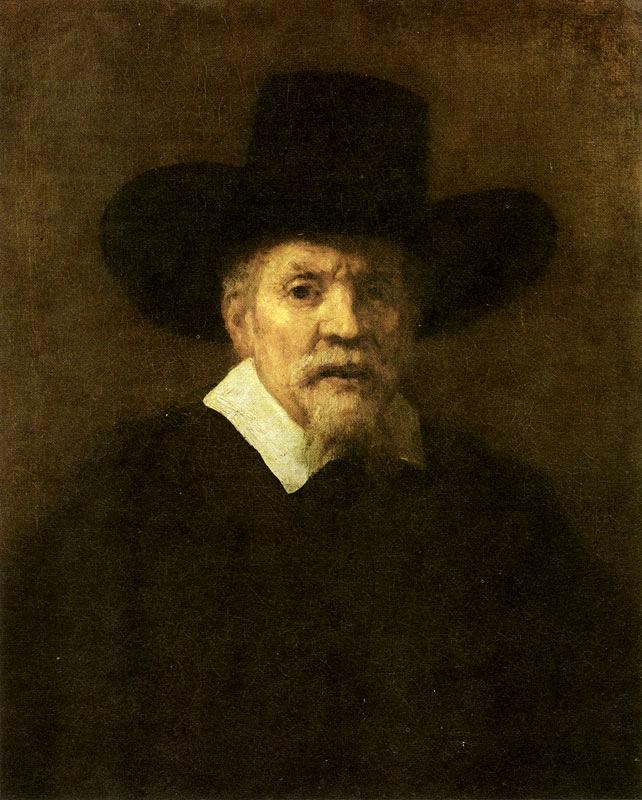
545. The Doctor Arnold Tholinx. (Paris.)
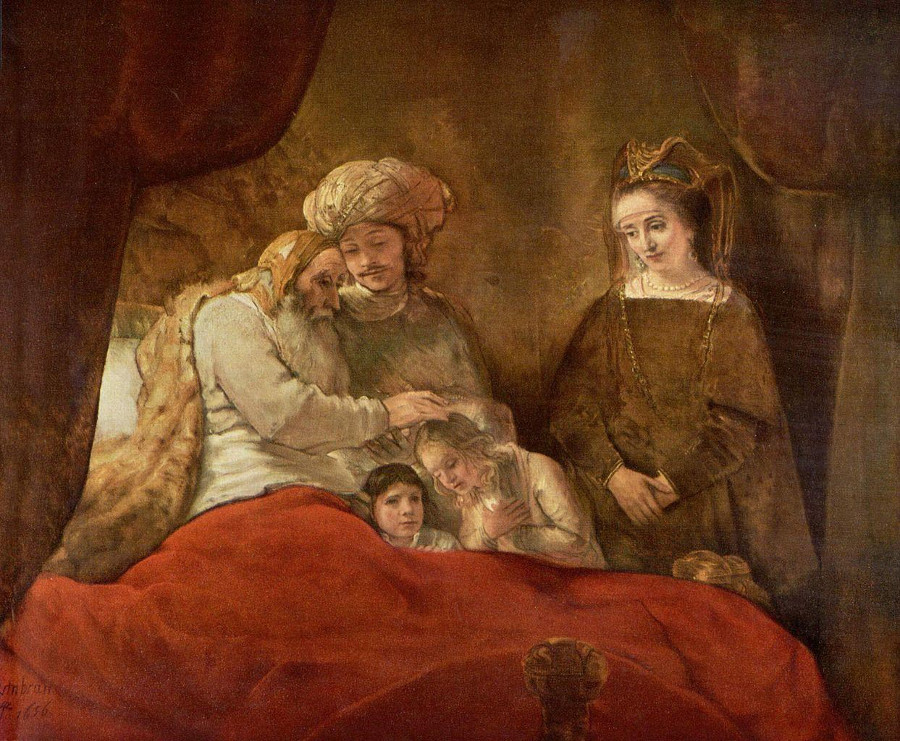
546. Jacob blessing Ephraim and Manasseh. (Cassel.)
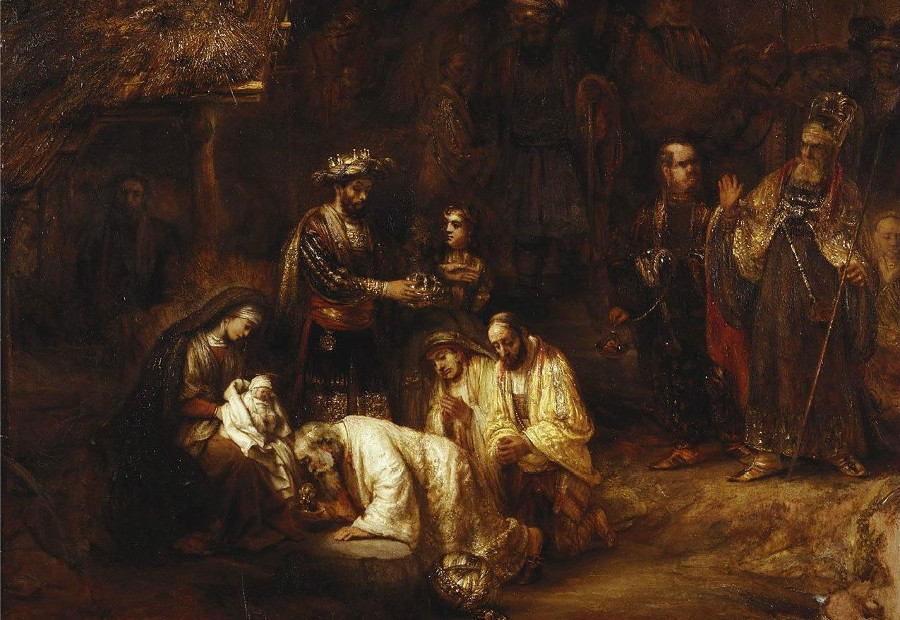
547. Adoration of the Magi. (Buckingham Palace.)
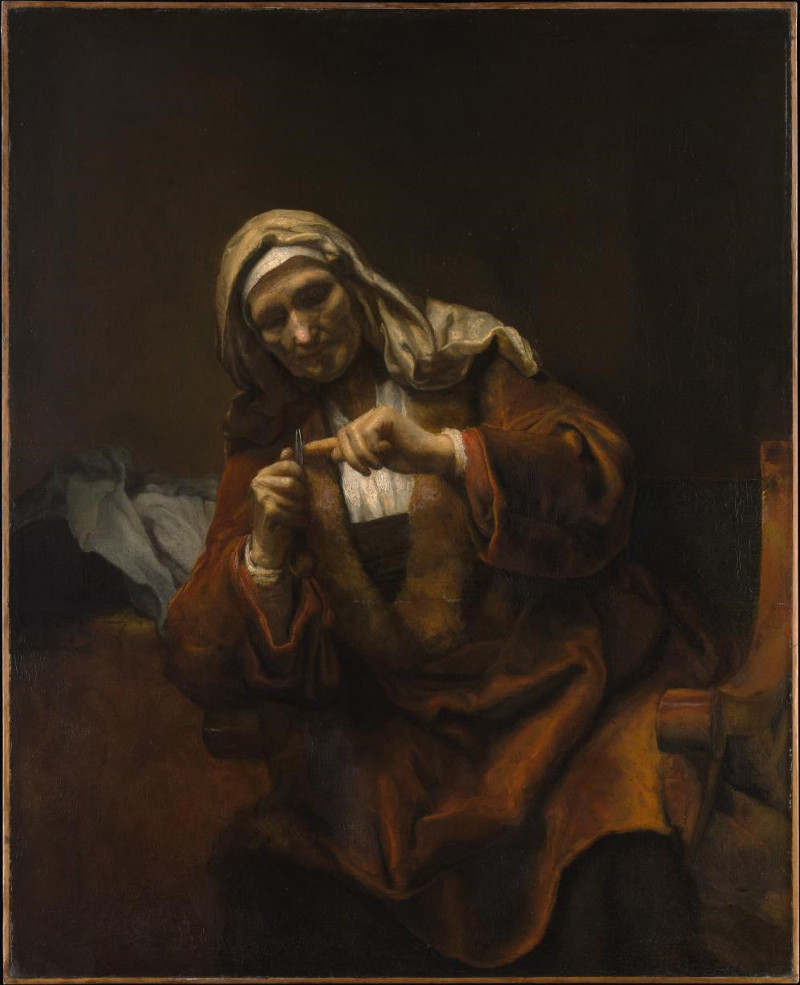
548. An Old Woman. (Paris.)
Look at this old woman.
Is she not really cutting her nails?
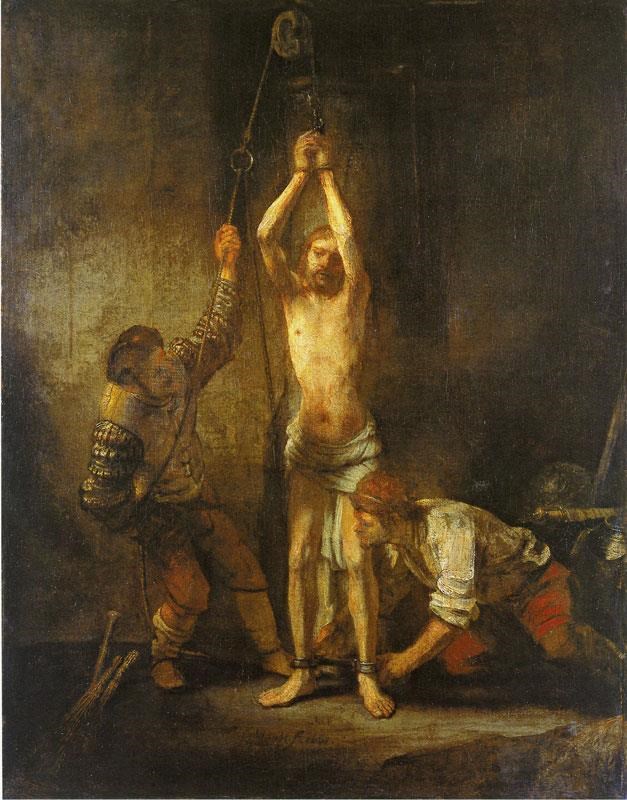
550. The Scourging of Christ. (Darmstadt.)
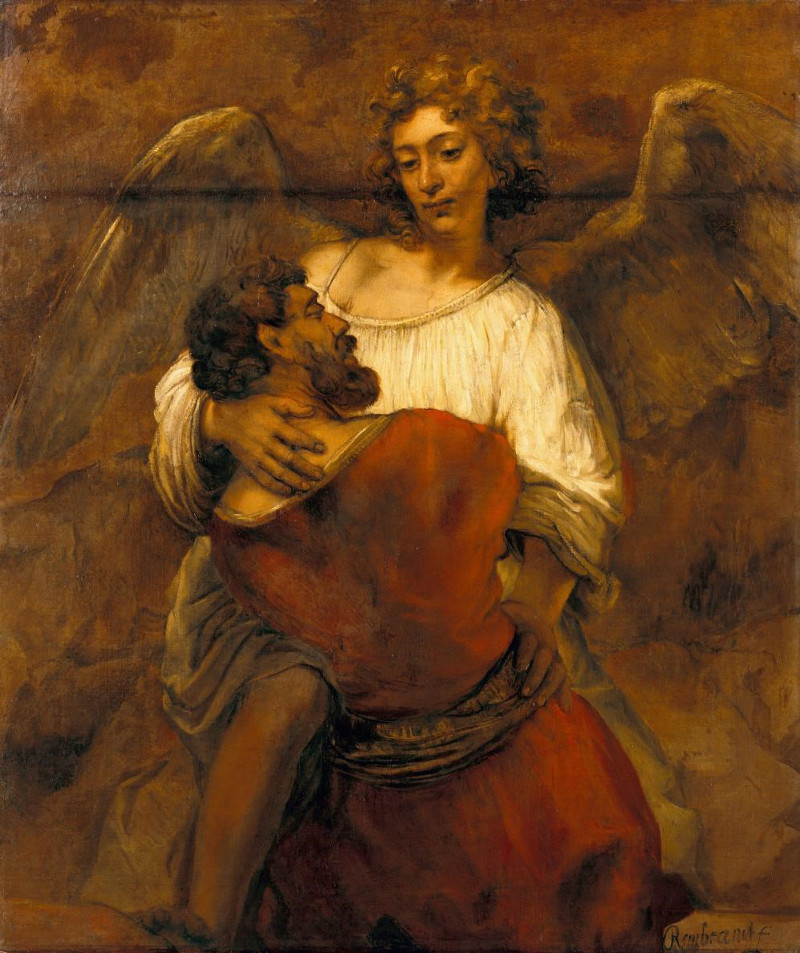
551. Jakob Wrestling with the Angel, 1659. (Berlin.)
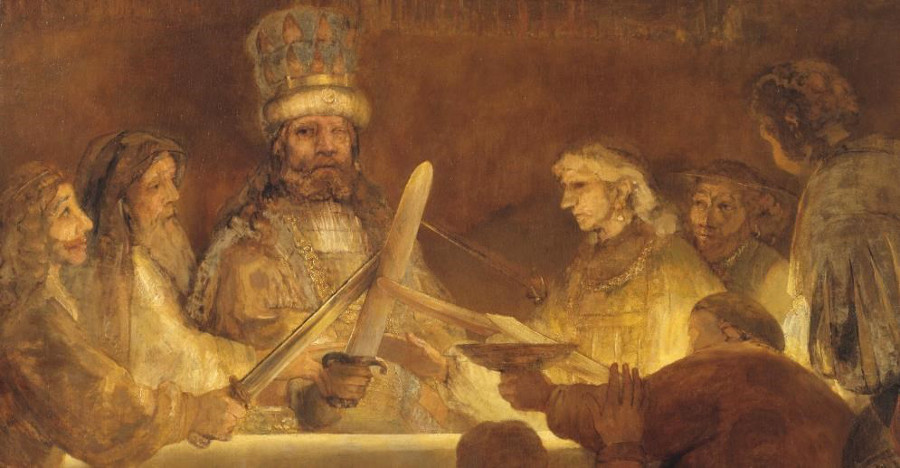
552. The Banquet of Julius Civilis or The leader of
the Batavians against the Romans, 1661. (Stockholm.)
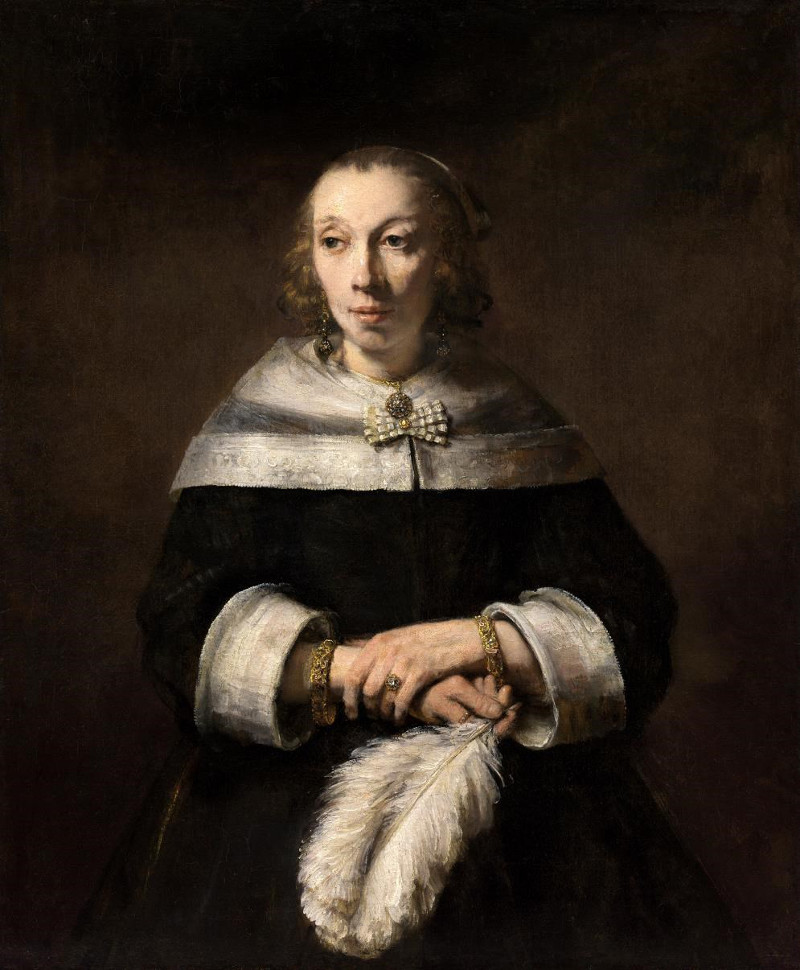
549. The Lady with the Ostrich Feathers.
(Philadelphia.)
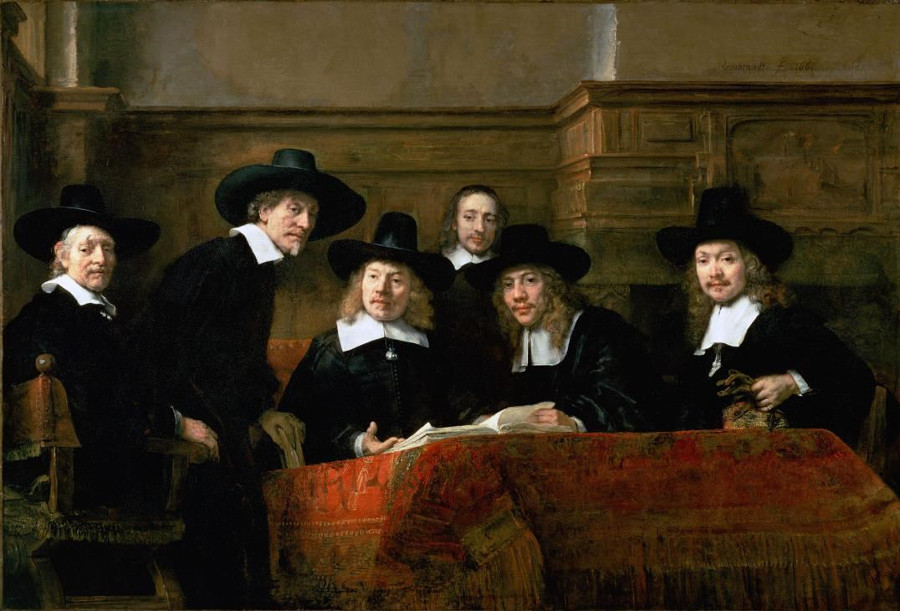
553. The Staal-Meisters. (Amsterdam.)
Here, again, we have a picture
painted by special command of these great gentlemen. Yet it is one of
his greatest masterpieces. See the wonderful simplicity with which they
are presented here — the dignitaries of the Guild whose task it
was to test the finished cloth and set their seal upon it as a sign
that it was good. They are the Presidents of a Clothmakers' Guild —
the Stall-Meisters. Of course, they club together to pay for the picture,
but as these were especially high lords and masters, Rembrandt must
see to it that this time no single face is eclipsed. Every face must
come out properly in full relief. And with the high artistic perfection
of this picture this is attained. These gentlemen did not go quite so
far as the Professors of Anatomy with their half-dissected corpse; one
of them holds in his hand a piece of paper on which their names are
recorded.

505. Anatomy of Professor Tulp. (The Hague.)
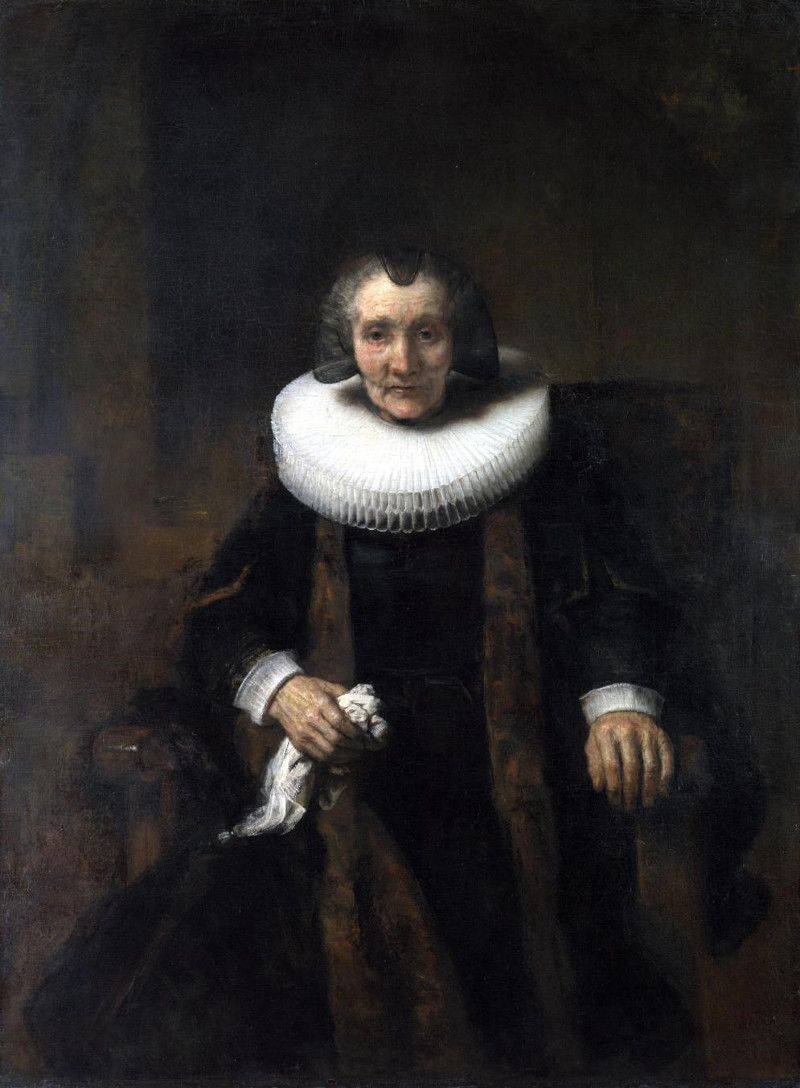
554. Portrait of an Old Woman. (National Gallery.
London.)
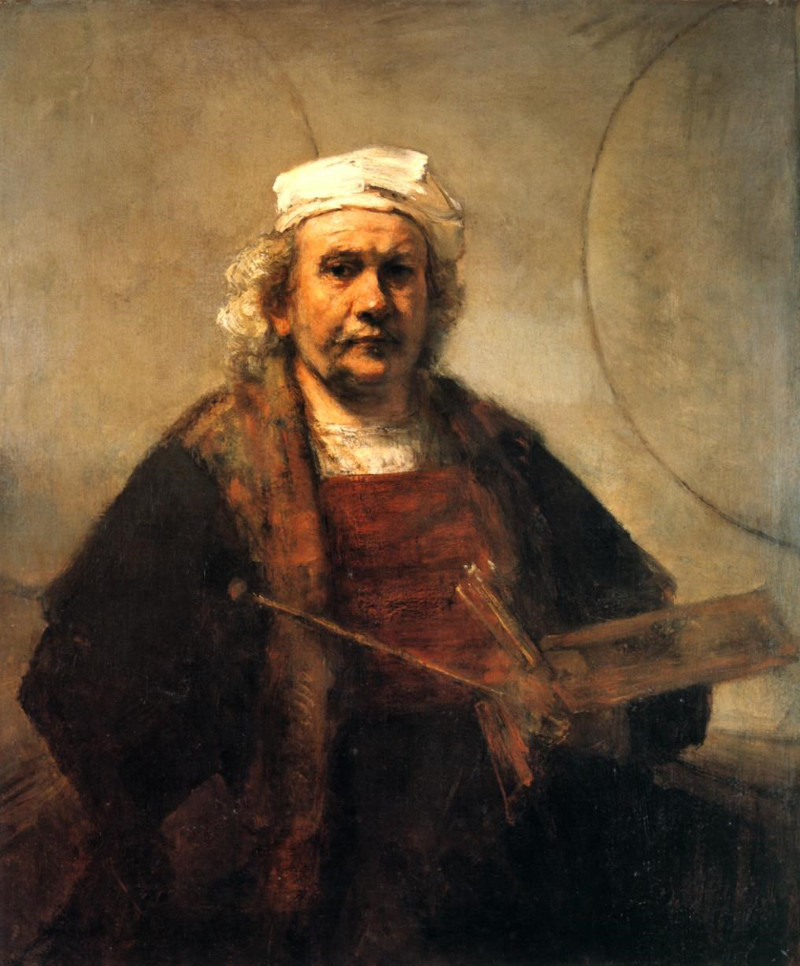
533. Portrait of Himself. (Lord Iveagh's Collection.
London.)
And now the work of a very
old Rembrandt:
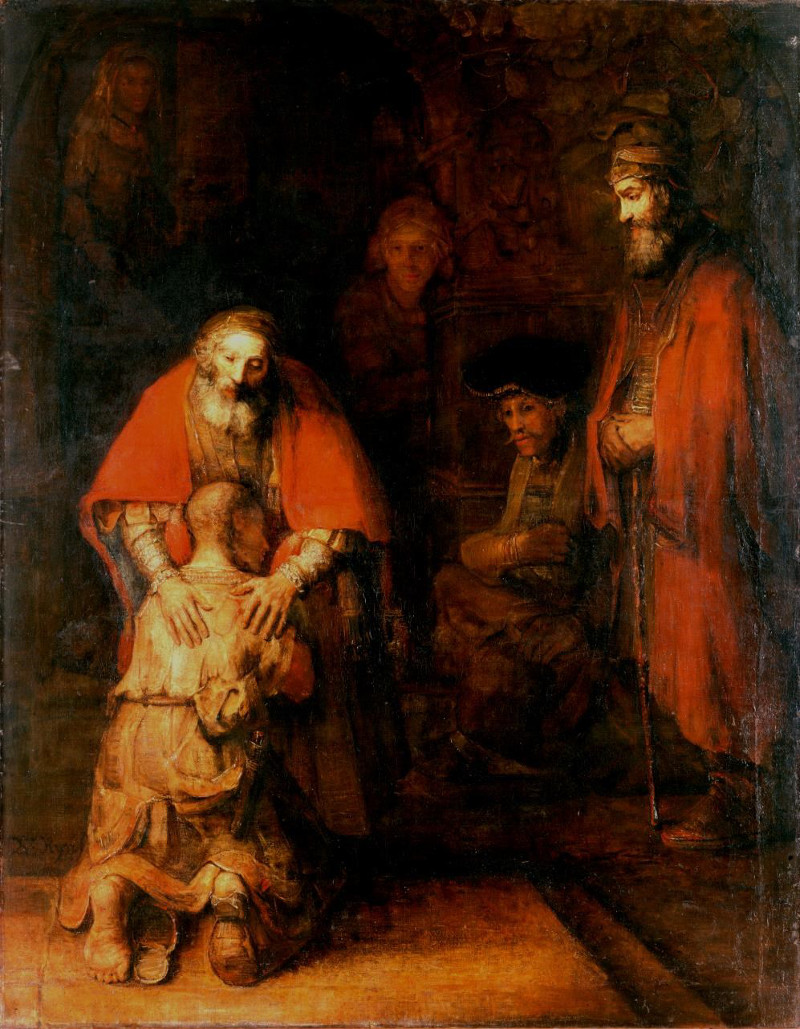
555. The Return of the Prodigal. (St. Petersburg.)
And now I wish to show you
the well-known picture of Faust.
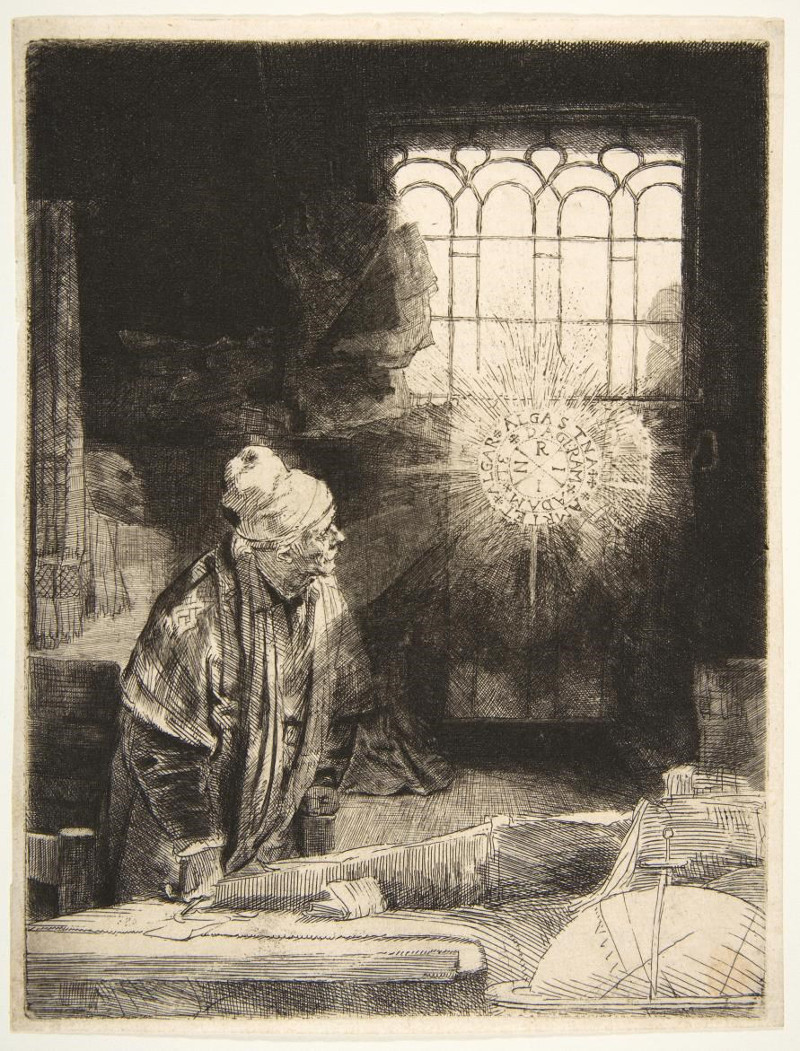
564. Dr. Faustus. (An etching.)
When we see this picture,
we are reminded of what I said in one of our last lectures — how
Goethe himself in his “Faust” portrays the figure of the
16th century in this weaving of the light. — But Rembrandt had
revealed it before Goethe.
I must not leave it unsaid
that to know Rembrandt fully it is most necessary to be acquainted with his
art as an etcher. The especial love for this Art is, indeed, characteristic
of that stream to which Rembrandt wished, above all, to devote himself.
He is no less great as an etcher co, than as a painter.
Etchings by Rembrandt:
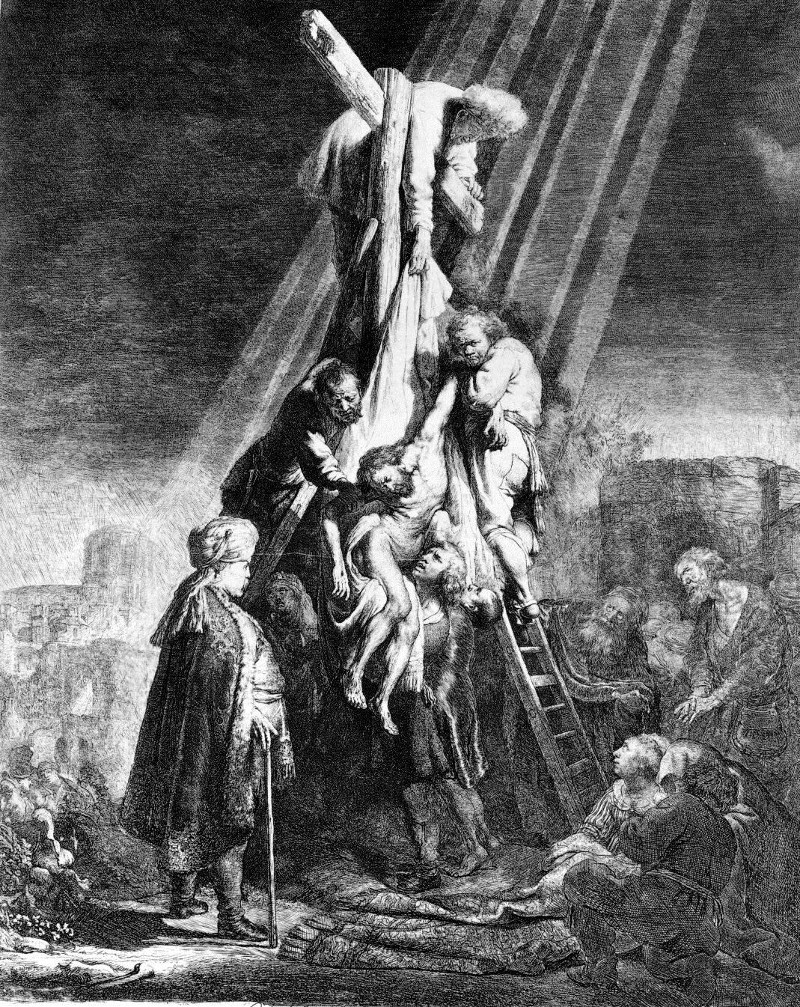
558. Descent From the Cross
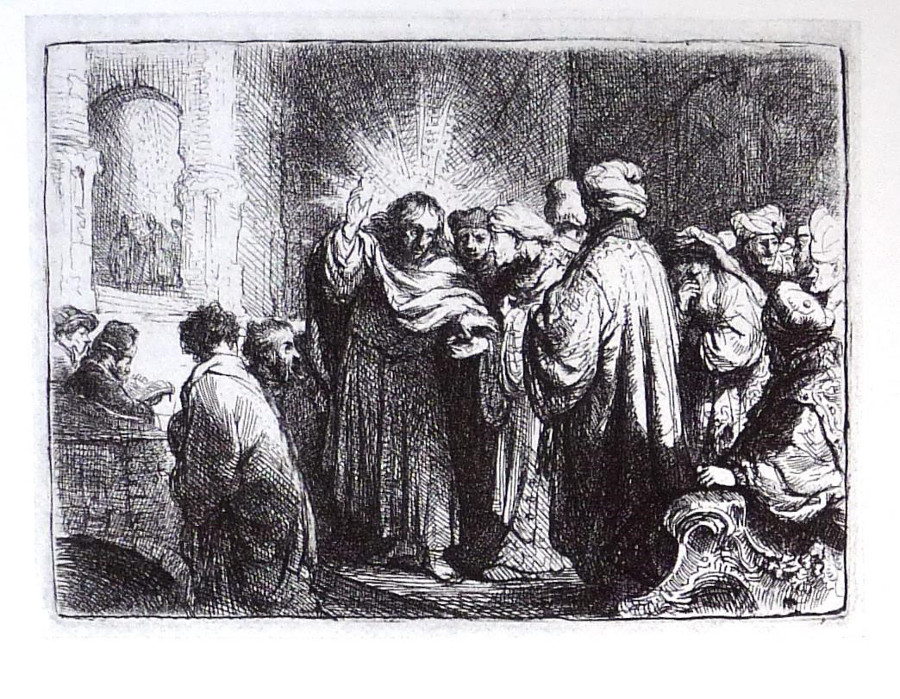
557. Tribute Money
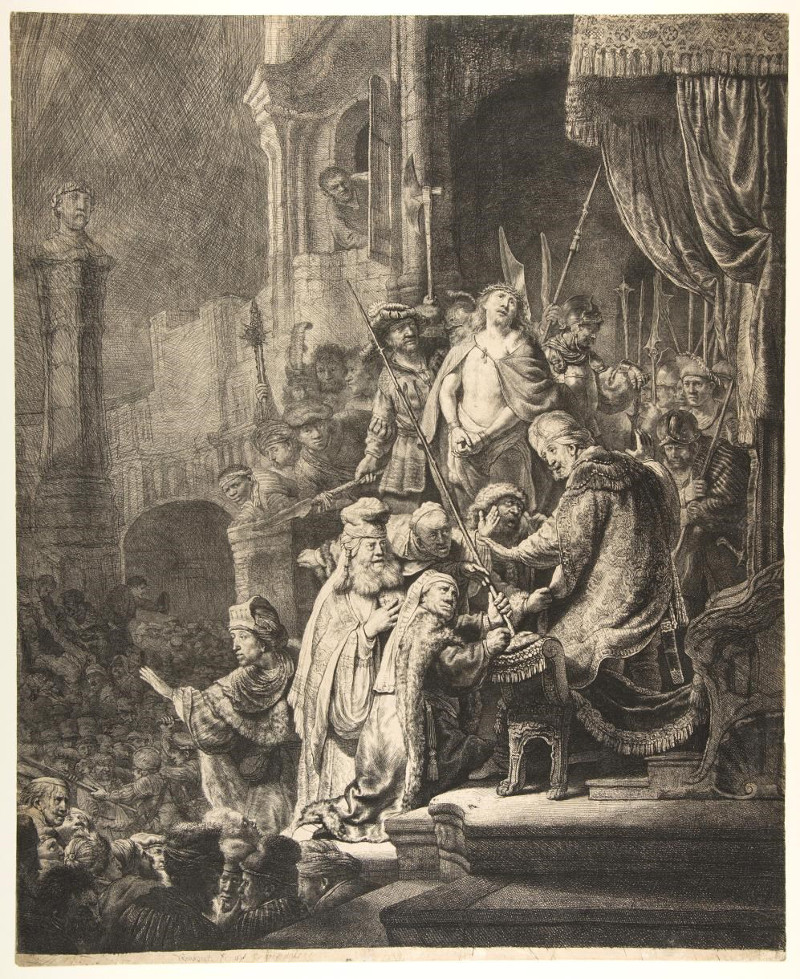
559. Ecce homo
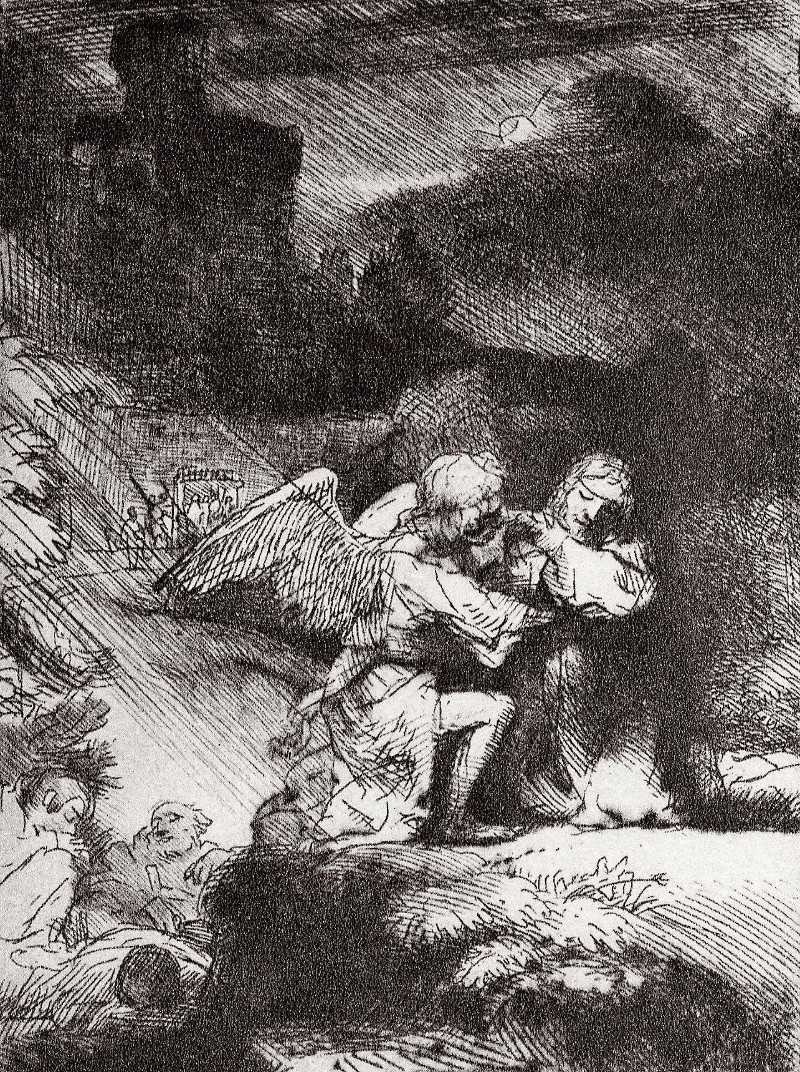
567. Christ of the Mount of Olives
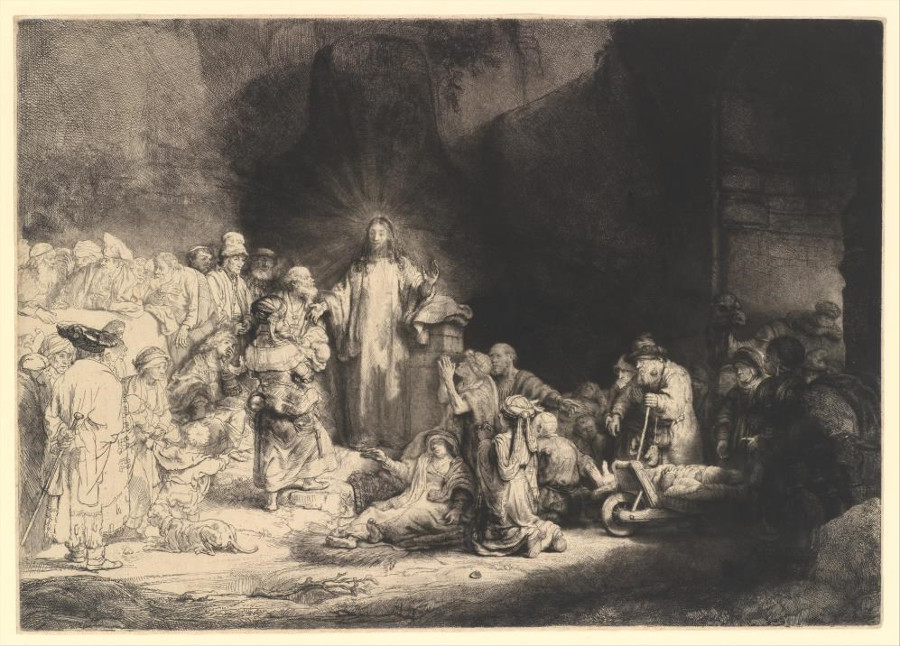
565. Christ Healing the Sick
This is the so-called
Hundred Guilder Print: “Come unto me all you who labor and
are burdened you ...”
We see in it the real beauty
of Rembrandt's art, especially in how these characteristic figures around
the Christ figure are expressed.
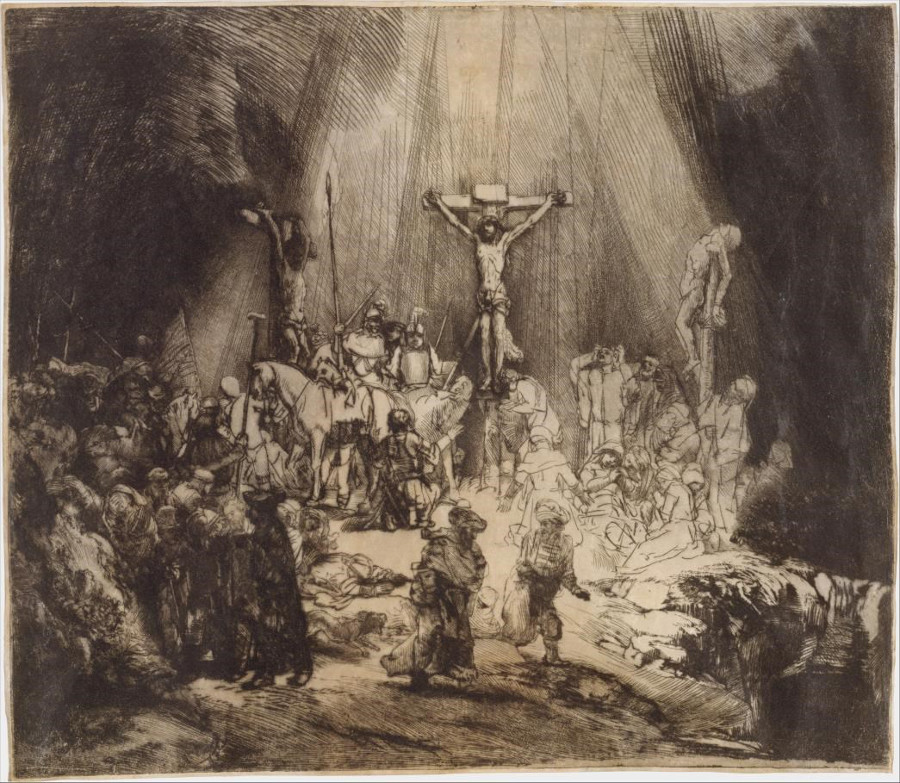
566. The Three Crosses
And now we want to add to
the self-portraits we have shown you as a final scene, another etching:
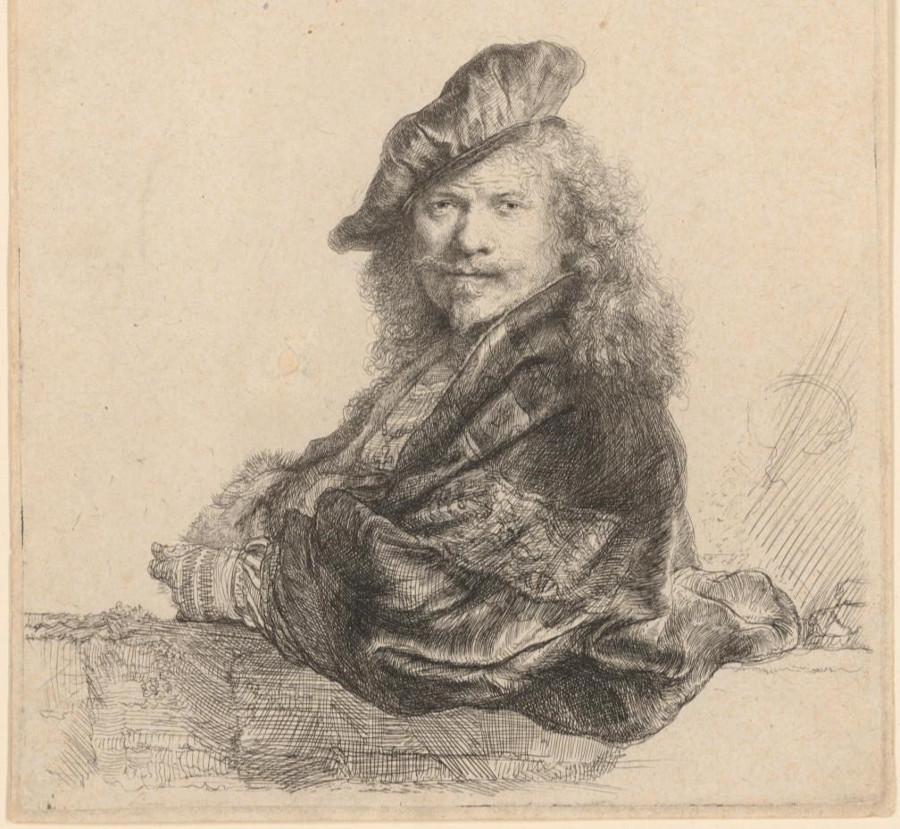
529. Self-portrait with propped arm, 1639.
How different is Rembrandt
from the other artists whose works we have seen during these lectures:
It was only in Dürer that we saw the first lighting-up of what
appears so wonderfully in Rembrandt. Rembrandt is a unique figure; he
stands alone and isolated. In the continuous study of the history of Art,
it is especially fascinating to dwell upon what is really characteristic
in the creations of single individualities. Rembrandt, above all, makes
us aware of the immediate individual presence of a strong and forceful,
mighty personality, lighting forth in the seventeenth century.
At a time like the present
it is not without importance that we should turn our gaze to an epoch
in which, beside all the devastation that was taking place in Europe,
there was this immediate and original creation out of a human soul —
a human soul of whom we may, indeed, believe that he was connected directly
with the prime sources and elements of world-existence.
I hope it will be given
to us while we can still be here together to show some other aspects
also of the continued development of Art.
|